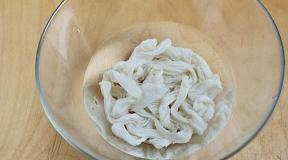Diseases from exposure to chemical dust. Occupational diseases dust lung diseases. Dust disease prevention measures
Dust is a professional and household irritant that causes dangerous diseases person. Getting into the body through the lungs, mucous membranes of the eyes, nasal cavities, skin, the smallest solid particles, floating freely in the air, have:
- poisonous action;
- allergenic;
- fibrogenic.
The dust may contain helminth eggs, plant pollen, mold micro-fungi, particles of dead insects.
Lung Disease Caused by Dust
The effect of dust on the parts of the respiratory system is determined by the shape and size of the particles. Particularly dangerous are poorly soluble particles less than 0.3 µm in elongated shape across. Some types of dust are naturally removed from the lungs over time, while others remain in the body forever, causing disease. The latter include silicates, natural and synthetic asbestos, asbestos-rubber, aluminosilicates.
Pneumoconiosis
Pneumoconiosis is a group of lung diseases caused by the penetration of dust particles into the respiratory tract. The name of the disease comes from the Greek pnéumōn, "lungs," and konía, meaning "dust." In addition to mechanical trauma to the mucous membranes of the bronchi, trachea, and lungs, the ability of a number of substances that enter the respiratory tract to dissolve in the body's fluids with the formation of toxic compounds is dangerous. Silicon dioxide, silicates, beryllium, some types of organic particles cause proliferation of connective tissue, lead to pneumosclerosis.
Dust bronchitis, tracheitis, asthma
The onset of the disease is facilitated by:
- intensive physical labor in a dusty environment;
- smoking;
- age;
- aerosol spraying;
- infectious lung diseases.
The disease in the initial stages is asymptomatic, manifesting itself only as a dry cough. Subsequently, the cough intensifies, becomes paroxysmal, then shortness of breath, weakness, sweating join.
Conjunctivitis
Dust particles of different nature mechanically irritate the mucous membrane of the eyes, cause dryness, feeling foreign body, redness, swelling of the eyelids, inflammation in the cornea. Contact with the dust of microfungi can cause purulent conjunctivitis with the formation of yellowish films, nodular infiltrates from leukocytes and cells of the mucous epithelium with involvement of the eye tissues in the pathological process.
In addition to mechanical irritation, dust can cause allergic conjunctivitis. Particular harm to health is caused by seasonal exacerbations of the disease during the flowering of some plants. The patient experiences photophobia, pain, burning in the eyes, watery eyes.
Dermatoconiosis
The action of cement dust, fiberglass particles, tobacco, talcum powder, flour and other damaging agents on the skin leads to the appearance of skin rashes, erythematous spots, blisters, and bloody crusts. The disease is accompanied by itching, redness of the affected area. The course of the disease depends on the condition of the skin, dustiness and humidity of the environment. Good ventilation of the room, elimination of dust sources, hygienic clothing prevent the onset of dermatoconiosis.











































































Src = "https://present5.com/presentation/3/4777479_234966450.pdf-img/4777479_234966450.pdf-1.jpg" alt = "(! LANG:> PROFESSIONAL DISEASES Dust lung diseases Prof. Solovyova, MD AND.">!}
Src = "https://present5.com/presentation/3/4777479_234966450.pdf-img/4777479_234966450.pdf-2.jpg" alt = "(! LANG:> Non-inflammatory diseases of the respiratory system silicosis; silicosis (asbestosis, talc, cementum ,"> Невоспалительные заболевания дыхательной системы силикоз; силикатозы (асбестоз, талькоз, цементный, слюдяной, нефелиновый, ОЛИВИНОВЫЙ каолиноз); металлокониозы (бериллиоз, сидероз, алюминоз, баритоз, манганокониоз, пневмокониозы, обусловленные пылью редкоземельных твердых и тяжелых сплавов); карбокониозы (антракоз, графитоз, сажевыйпневмокониоз); пневмокониозы, обусловленные вдыханием смешанной пыли (антракосиликоз, сидеросили коз, силикосиликатоз); пневмокониозы, обусловленные вдыханием органической пыли (хлопковый, зерновой, пробковый, тростниковый). !}
Src = "https://present5.com/presentation/3/4777479_234966450.pdf-img/4777479_234966450.pdf-3.jpg" alt = "(! LANG:> In 1996 GU"> В 1996 г. ГУ "НИИ медицины труда" РАМН предложили новую класси фикацию пневмокониозов, изло женную в методических указаниях № 95/235 Министерства здравоохране ния и медицинской промышленности !} Russian Federation... 1) Developing from exposure to moderate and highly fibrogenic dust (with a free silicon dioxide content of more than 10%) - silicosis, anthracosilicosis, silicosiderosis, silicosilicatosis. These pneumoconioses are most common among sandblasters, chippers, tunnellers, farmers, barn workers, refractory workers, and ceramic workers. They are prone to progression of the fibrous process and complication of tuberculosis infection.
Src = "https://present5.com/presentation/3/4777479_234966450.pdf-img/4777479_234966450.pdf-4.jpg" alt = "(! LANG:> pneumoconiosis is characterized by moderate fibrosis, benign and slow progressing,"> пневмокониозы характеризуется умеренно выраженным пневмофиброзом, доброкачественным и медленнопрогрессирующим течением, нередко осложняются неспецифической инфекцией, хроническим бронхитом, что в основном определяет тяжесть заболевания. 2) Развивающиеся от воздействия слабофиброгенной пыли (с содержанием свободного диоксида кремния меньше 10 % или не содержащей его) – силикатозы (асбестоз, талькоз, каолиноз, оливиноз, нефелиноз, пневмокониоз от воздействия цементной пыли), карбокониозы (антракоз, графитоз, сажевый пневмокониоз и др.), пневмокониоз шлифовальщиков и наждачников, метал локониозы или пневмокониозы от рентгеноконтрастных видов пыли (сидероз, в т. ч. от аэрозоля при электросварке или газорезке железных изделий, баритоз, станиоз, мангано кониоз и др.).!}
Src = "https://present5.com/presentation/3/4777479_234966450.pdf-img/4777479_234966450.pdf-5.jpg" alt = "(! LANG:> 3) Developing from exposure to aerosols of toxic allergic action (dust containing"> 3) Развивающиеся от воздействия аэрозолей токсико аллергического действия (пыль, содержащая металлы аллергены, компоненты пластмасс и других полимерных материалов, органические пыли и др.) бериллиоз, алюминоз, легкое фермера и другие гиперчувствительные пневмониты. В начальных стадиях заболевания характеризуются клинической картиной хронического бронхиолита, альвеолита прогрессирующего течения с исходом в фиброз. Концентрация пыли не имеет решающего значения в развитии данной группы пневмокониозов. Заболевание возникает при незначительном, но длительном и постоянном контакте с аллергеном.!}
Src = "https://present5.com/presentation/3/4777479_234966450.pdf-img/4777479_234966450.pdf-6.jpg" alt = "(! LANG:> groups of factors affecting the nature and severity of the response of lung tissue to"> группы факторов, влияющих на характер и степень выраженности реакции легочной ткани на минеральную пыль Концентрация пыли, интенсивность ее экспонирования, длительность контакта (стажа работы). Индивидуальная чувствительность к пыли и наличие факторов, предрасполагающих к развитию фиброза. Характер пыли, геометрические размеры частиц и аэродинамические свойства.!}
Src = "https://present5.com/presentation/3/4777479_234966450.pdf-img/4777479_234966450.pdf-7.jpg" alt = "(! LANG:> Immunological theory of pneumoconiosis silicosis develops in quartz particle phagocytosis"> Иммунологическая теория пневмокониозов силикоз развивается при фагоцитозе кварцевых частиц макрофагами. Скорость гибели макрофагов пропорциональна фиброгенной агрессивности пыли. Гибель макрофагов первый и обязательный этап в образовании силикотического узелка. Протеолитические энзимы, такие как металлопротеиназы и эластаза, высвобождающиеся из поврежденных макрофагов, в свою очередь также способствуют разрушению легочных структур.!}
Src = "https://present5.com/presentation/3/4777479_234966450.pdf-img/4777479_234966450.pdf-8.jpg" alt = "(! LANG:> Immunological theory of pneumoconiosis The inflammation phase is accompanied by reparative processes, with"> Иммунологическая теория пневмокониозов Фаза воспаления сопровождается репаративными процессами, при которых факторы роста стимулируют выработку и пролиферацию мезенхимальных клеток, регулируют образование новых сосудов и эпителия в поврежденных тканях. Неконтролируемые механизмы неоваскуляризацин и эпителизации могут легко привести к развитию фиброза. Фиброгенные частицы пыли самостоятельно активируют !} proinflammatory cytokines(Il 1 and TNF). A relationship between silicosis and the HLA system was found, possibly determining the nature of the immune response.
Src = "https://present5.com/presentation/3/4777479_234966450.pdf-img/4777479_234966450.pdf-9.jpg" alt = "(! LANG:> SILICOSIS cough, phlegm and shortness of breath on exertion."> СИЛИКОЗ кашель, мокрота и одышка при физической нагрузке. При формировании крупных фиброзных узлов и изменений со стороны плевры появляются жалобы на боли в грудной клетке, покалывания под лопатками. Перкуторный звук укорачивается, а с образованием эмфиземы появляется коробочный оттенок. Аускультативно вначале выслушивается жесткое дыхание, которое сменяется ослабленным по мере нарастания эмфиземы, появляются хрипы. Ведущим методом диагностики является стандартная рентгенография легких. В рентгенологической классификации выделяют малые и большие затемнения.!}
Src = "https://present5.com/presentation/3/4777479_234966450.pdf-img/4777479_234966450.pdf-10.jpg" alt = "(! LANG:> Development of emphysema A - norm B - emphysema - expansion of alveolar"> Развитие эмфиземы А – норма Б – эмфизема – расширение альвеолярных ходов, уплощение альвео!}
Src = "https://present5.com/presentation/3/4777479_234966450.pdf-img/4777479_234966450.pdf-11.jpg" alt = "(! LANG:> Emphysema. Dr. H. O. van der Zalm, 1976 Centriacinar,"> Эмфизема легких. Dr. H. O. van der Zalm, 1976 Центриацинарная, Диффузная эмфизема буллезная эмфизема!}
Src = "https://present5.com/presentation/3/4777479_234966450.pdf-img/4777479_234966450.pdf-12.jpg" alt = "(! LANG:> Emphysema of the lungs">!}
Src = "https://present5.com/presentation/3/4777479_234966450.pdf-img/4777479_234966450.pdf-13.jpg" alt = "(! LANG:> Emphysema of the lungs">!}
Src = "https://present5.com/presentation/3/4777479_234966450.pdf-img/4777479_234966450.pdf-14.jpg" alt = "(! LANG:> Pulmonary emphysema, uneven elasticity of the alveolar frame, vascular changes">!}
Src = "https://present5.com/presentation/3/4777479_234966450.pdf-img/4777479_234966450.pdf-15.jpg" alt = "(! LANG:> Long-term development of silicosis With relatively short exposure to large"> Отдаленные сроки развития силикоза При относительно непродолжительном воздействии больших концентраций кварцсодержащей пыли может иметь место запоздалая реакция на нее с формированием т. н. позднего силикоза. Это особая форма болезни, развивающаяся спустя 10 20 и более лет после прекращения работы с пылью. Стаж работы у этих больных обычно не превышает 4- 5 лет.!}
Src = "https://present5.com/presentation/3/4777479_234966450.pdf-img/4777479_234966450.pdf-16.jpg" alt = "(! LANG:> Asbestosis The most dangerous and severe pneumoconiosis downstream"> Асбестоз Самым опасным и тяжелым по течению пневмокониозом является асбестоз, вызванный вдыханием пыли асбеста волокнистого бесструктурного гидросиликата, стойкого к воздействию высоких температур. амфиболовый асбест, отличается от хризотилового большейтоксичностью, фиброгенностью и канцерогенностью.!}
Src = "https://present5.com/presentation/3/4777479_234966450.pdf-img/4777479_234966450.pdf-17.jpg" alt = "(! LANG:> Where can you find asbestos? The main materials made from asbestos are :"> Где можно встретить асбест? Основными материалами, изготовленными из асбеста, являются: арматура труб, кровельные покрытия, клепальные изделия, панели для стен и полов, гофрированные и формовые листы, асбестовая бумага для изоляции проводов и труб, тормозные накладки и накладки для сцепления, синтетиче ская пряжа, шнур, веревки и т. д.!}
Src = "https://present5.com/presentation/3/4777479_234966450.pdf-img/4777479_234966450.pdf-18.jpg" alt = "(! LANG:> MPC for asbestos According to international standards, the maximum permissible concentration of asbestos"> ПДК асбеста Согласно международным стандартам, предельно допустимой концентрацией асбеста в зоне дыхания рабочего считается одно фиброволокно на 1 см 3 воздуха. Санитарно гигиенический регламент США допу скает не более 0, 1 фиброволокна/см 3. Решающим для подтверждения наличия асбестоза как профессионального заболевания является обнаружение асбестовых волокон на рабочем месте, а также выявление специфических асбестовых (железистых) телец в биологических средах и тканях организма.!}
Src = "https://present5.com/presentation/3/4777479_234966450.pdf-img/4777479_234966450.pdf-19.jpg" alt = "(! LANG:> Limestone dolomite pneumoconiosis A pathological process caused by limestone dolomite dust,"> Известняково доломитовый пневмокониоз Патологический процесс, вызываемый известняково доломитовой пылью, развивается в респираторных и бронхиальных структурах легких и в дальнейшем траснформируется в интерстициальный пневмосклероз и атрофический бронхит. Пневмосклеретические изменения в легких, носящие интерстициальный характер, а клинически - фарингиты, бронхиты и эмфизему!}
Src = "https://present5.com/presentation/3/4777479_234966450.pdf-img/4777479_234966450.pdf-20.jpg" alt = "(! LANG:> Metalloconioses are caused by inhalation of metal dust: beryllium"> Металлокониозы обусловлены вдыханием металлической пыли: бериллия (бериллиоз), железа (сидероз), алюминия (алюминоз), бария (баритоз) и т. д. Наиболее распространенным является сидероз, который развивается у горнорабочих при добыче железа и его переработке, у сталеплавильщиков, газо и электросварщиков при работе в замкнутых пространствах и других лиц, имеющих контакт с пылью железа при сварке, нарезке и обработке изделий!}
Src = "https://present5.com/presentation/3/4777479_234966450.pdf-img/4777479_234966450.pdf-21.jpg" alt = "(! LANG:> Onset of metalloconiosis."> Начало металлокониозов Манифестацией заболевания считается появление на рентгенограмме мелкопятнистых теней повышенной плотности, разбросанных по всем легочным полям без образования конгломератов. Несоответствие скудных !} clinical symptoms distinct changes in the X-ray diffraction pattern are explained by the impermeability of the electric welding aerosol for x-rays... With the termination of work in contact with iron dust or welding aerosol, all X-ray logical changes can disappear (regressive pneumoconiosis).
Src = "https://present5.com/presentation/3/4777479_234966450.pdf-img/4777479_234966450.pdf-22.jpg" alt = "(! LANG:>"> Карбокониозы Развиваются при длительном контакте с углеродсодержащеи пылью (уголь, графит, сажа). Характерным для них является умеренновыраженный мелкоочаговый и интерстициальный фиброз легких. Одним из распространенных заболеваний этой группы является антракоз, вызванный вдыханием дисперсной угольной пыли!}
Src = "https://present5.com/presentation/3/4777479_234966450.pdf-img/4777479_234966450.pdf-23.jpg" alt = "(! LANG:>"> Диагностика ПЗЛ исследование функции внешнего дыхания (ФВД), проведение фибробронхоскопии, стандартной рентгенографии легких, рентгеновской томографии, компьютерной и магнитно !} resonance imaging(with suspicion of vascular genesis of changes in the lungs), specific laboratory tests. biopsy of lung tissue and intrathoracic lymph nodes.
Src = "https://present5.com/presentation/3/4777479_234966450.pdf-img/4777479_234966450.pdf-24.jpg" alt = "(! LANG:> Radiography of the lungs I. Small opacities are characterized by shape, size, profusion"> Рентгенография легких I. Малые затемнения характеризуются формой, размерами, профузией (численной плотностью на 1 см 2) и распространением по зонам правого и левого легкого: а) округлые (узелковые): р 1, 5 мм; q- 1, 5 3, 0 мм; r до 10, 0 мм; б) линейные (интерстициальные): s тонкие линейные до 1, 5 мм шириной; t средние линейные до 3, 0 мм шириной; u грубые, пятнистые, неправильные до 10, 0 мм.!}
Src = "https://present5.com/presentation/3/4777479_234966450.pdf-img/4777479_234966450.pdf-25.jpg" alt = "(! LANG:> Radiography of the lungs Small round-shaped opacities have clear contours, medium"> Рентгенография легких Малые затемнения округлой формы имеют четкие контуры, среднюю интенсивность, мономорфные, диффузно располагаются преимущественно в верхних и средних отделах легких. Малые линейные неправильной формы затемнения, отражающие перибронхиальный, периваскулярный и межуточный фиброзы, имеют сетчатую, ячеистую или тяжисто ячеистую форму, располагаются преимущественно в средних и нижних отделах легких. Символы записываются дважды: (р/р, q/q, r/r)или(р/u, q/t, p/s).!}
Src = "https://present5.com/presentation/3/4777479_234966450.pdf-img/4777479_234966450.pdf-26.jpg" alt = "(! LANG:> Saturation density or concentration of small opacities per 1 cm 2 of the pulmonary field"> Плотность насыщения или концентрация малых затемнений на 1 см 2 легочного поля шифруется арабскими цифрами: 1 - единичные, легочный бронхо сосудистый рисунок прослеживается; 2 немногочисленные мелкие тени, легочный бронхо сосудистый рисунок дифференцируется частично; 3 множественные малые затемнения, легочный бронхо сосудистый рисунок не дифференцируется. Например, 0/0, 0/1, 1/0, 3/3 и т. д. Числитель основные формы, знаменатель другие. II. Большие затемнения (результат слияния округлых затемнений на месте ателектазов, пневмонических фокусов, при осложнении туберкулезом): А до 50 мм; В до 100 мм; С более 100 мм.!}
Src = "https://present5.com/presentation/3/4777479_234966450.pdf-img/4777479_234966450.pdf-27.jpg" alt = "(! LANG:> Based on the radiological characteristics, interstitial pneumoconiosis forms are distinguished,"> Исходя из рентгенологической характеристики выделяют формы пневмокониозов интерстициальную, узелковую узловую!}
Src = "https://present5.com/presentation/3/4777479_234966450.pdf-img/4777479_234966450.pdf-28.jpg" alt = "(! LANG:> Bronchodilator test FEV 1 spirometry must be measured (at least twice, difference"> Бронходилаторный тест Спирометрия ОФВ 1 должно быть измерено (минимум дважды, разница в 5%) до ингаляции бронходилататора. Бронходилататор должен быть ингалирован посредством устройства MDI (баллончик) + спейсер или через небулайзер, чтобы быть убежденным что вещество поступило в легкие Доза бронходилататора должна быть выбрана максимальной для пациента (в зависимости от кривой потока)!}
Src = "https://present5.com/presentation/3/4777479_234966450.pdf-img/4777479_234966450.pdf-29.jpg" alt = "(! LANG:> Bronchodilator test Spirometry Possible doses of substances: ü 400"> Бронходилаторный тест Спирометрия Возможные дозы веществ: ü 400 µg β 2 -агониста, или ü 80 -160 µg антихолинергика, или ü комбинация двух веществ ОФВ 1 должно быть измерено снова: ü 10 -15 минут после β 2 -агониста ü 30 -45 минут после антихолинергика или комбинации!}
Src = "https://present5.com/presentation/3/4777479_234966450.pdf-img/4777479_234966450.pdf-30.jpg" alt = "(! LANG:> Bronchodilator test Results Any increase in FEV 1 greater than / equal to 200 ml and 12%"> Бронходилаторный тест Результаты Любое повышение ОФВ 1 которое более/равно 200 мл и 12% прироста от исходного показателя ОФВ 1 расценивается как достоверное (тест положительный). Обычно полезным для клинической интерпретации является указание как абсолютных изменений в мл от исходного, так и % прироста от базовой линии.!}
Src = "https://present5.com/presentation/3/4777479_234966450.pdf-img/4777479_234966450.pdf-31.jpg" alt = "(! LANG:> TREATMENT OF PZD Specific pathogenetic therapy pneumoconiosis does not exist. "> TREATMENT OF PZL There is no specific pathogenetic therapy for pneumoconiosis. Patients receive treatment aimed at reducing inflammation in the lung tissue, improving the drainage function of the bronchi and eliminating dust particles
Src = "https://present5.com/presentation/3/4777479_234966450.pdf-img/4777479_234966450.pdf-32.jpg" alt = "(! LANG:> Labor recommendation for dust bronchitis For uncomplicated cases of dust bronchitis"> Трудовые рекомендации при пылевом бронхите При неосложненных случаях пылевого бронхита больному противопоказан труд с воздействием: пыли, неблагоприятных факторов микро и макроклимата, веществ раздражающего органы дыхания действия, физического перенапряжения.!}
Src = "https://present5.com/presentation/3/4777479_234966450.pdf-img/4777479_234966450.pdf-33.jpg" alt = "(! LANG:> Treatment of Specific, pathogenetic therapy of pneumoconiosis, chronic dust"> Лечение Специфической, патогенетической терапии пневмокониозов, хронического пылевого бронхита и биссиноза не существует. Больным проводят лечение, направленное на снижение воспаления в ткани легкого, улучшение дренажной функции бронхов и элиминацию пылевых частиц!}
Src = "https://present5.com/presentation/3/4777479_234966450.pdf-img/4777479_234966450.pdf-34.jpg" alt = "(! LANG:> TREATMENT The basic therapy is formed by bronchodilators, since it is bronchial"> ЛЕЧЕНИЕ Базисную терапию формируют бронходилататоры, поскольку именно бронхиальная обструкция наряду с прогрессированием пневмосклероза играет первостепенную роль в патогенезе и прогрессировании. β 2–агонисты быстро воздействуют на бронхиальную обструкцию, улучшая самочувствие больных в короткие сроки. При длительном применении β 2– агонистов к ним развивается резистентность, после перерыва в приеме препаратов их бронхорасширяющее действие восстанавливается.!}
Src = "https://present5.com/presentation/3/4777479_234966450.pdf-img/4777479_234966450.pdf-35.jpg" alt = "(! LANG:> Classification of bronchodilators Duration 2 - Agonists Anticholinergic blockers of Salbutamo action"> Классификация бронхолитиков Длительность 2 -Агонисты Холиноблокаторы действия Сальбутамо л Ипратропия Короткого бромид действия Фенотерол Окситропиум Тербуталин Сальметеро л Тиотропия Длительного действия бромид Формотерол Препараты теофиллина Резервные медленного высвобождения; препараты!}
Src = "https://present5.com/presentation/3/4777479_234966450.pdf-img/4777479_234966450.pdf-36.jpg" alt = "(! LANG:> Treatment of exacerbations of BRONCHOLITICS"> Лечение обострений БРОНХОЛИТИКИ Анти- Метилксантины β 2 -Агонисты холинергические (теофиллин) препараты Быстрый и сильный Продолжительный Слабый бронхолитический эффект эффект Расслабляют гладкую Снижение холинергического Высокая токсичность мускулатуру бронхов тонуса ветвей блуждающего Возможна дозозависимая нерва кардиотоксичночть Отсутствие кардиотоксичности!}
Src = "https://present5.com/presentation/3/4777479_234966450.pdf-img/4777479_234966450.pdf-37.jpg" alt = "(! LANG:> BERODUAL N Two-in-one composition THE ONLY AND UNIQUE COMBINED BRONCHOLITION"> БЕРОДУАЛ Н Состав «два в одном» ЕДИНСТВЕННЫЙ И УНИКАЛЬНЫЙ КОМБИНИРОВАННЫЙ БРОНХОЛИТИК (не содержит гормональный компонент) СИЛА ДЛИТЕЛЬНОСТЬ β 2 агониста Антихолинергика Фенотерол 50 мкг Ипратропиум 20 мкг БЕРОДУАЛ Н!}
Src = "https://present5.com/presentation/3/4777479_234966450.pdf-img/4777479_234966450.pdf-38.jpg" alt = "(! LANG:> Safety and dosing regimen Does not contain hormonal component"> Безопасность и режим дозирования Не содержит гормональный компонент Безопасность Лечение приступов Низкая доза β 2 агониста 2 ингаляции (через 5 мин. повторные 2 ингаляции) Возможность применения у пациентов с сердечно Длительная терапия сосудистыми заболеваниями Опыт применения в России более По 1 2 ингаляции 3 раза в сутки (до 20 лет 8 ингаляций в сутки)!}
Src = "https://present5.com/presentation/3/4777479_234966450.pdf-img/4777479_234966450.pdf-39.jpg" alt = "(! LANG:> Berodual For mild to moderate attacks in many cases"> Беродуал При легких и умеренных приступах во многих случаях рекомендуется 1 мл (20 капель). В особенно тяжелых случаях, например у пациентов, находящихся в отделениях интенсивной терапии, при неэффективности доз, указанных выше, могут потребоваться более высокие дозы, до 2, 5 мл (50 капель). В особо тяжелых случаях возможно применение при условии медицинского наблюдения максимальной дозы, достигающей 4, 0 мл (80 капель). Курсовое и длительное лечение При необходимости !} reapplication for each injection use 1 2 ml (20 40 drops) up to 4 times a day. Maximum daily dose 8 ml. In the case of moderate bronchospasm or as an aid in the implementation of ventilation, a dose is recommended, the lower level of which is 0.5 ml (10 drops).
Src = "https://present5.com/presentation/3/4777479_234966450.pdf-img/4777479_234966450.pdf-40.jpg" alt = "(! LANG:> Delivery method medicinal substance affects the end result of treatment no less than "> The method of drug delivery affects the end result of treatment no less than the drug itself!
Src = "https://present5.com/presentation/3/4777479_234966450.pdf-img/4777479_234966450.pdf-41.jpg" alt = "(! LANG:> Main parameter of inhalation device efficiency Pulmonary aerosol deposition When used"> Основной параметр эффективности ингаляционного устройства Легочная депозиция аэрозоля При использовании ЗАВИСИТ ОТ: разных систем колеблется 1 Размера частиц аэрозоля в пределах от 4 до 85% от 2 Правильности ингаляционной техники отмеренной дозы. 3 Типа ингаляционного устройства!}
Src = "https://present5.com/presentation/3/4777479_234966450.pdf-img/4777479_234966450.pdf-42.jpg" alt = "(! LANG:> Distribution of aerosol particles in the respiratory tract * 5-10 microns"> Распределение частиц аэрозоля в дыхательных путях* 5 -10 мкм осаждение в ротоглотке, гортани, трахее 2 -5 мкм осаждение в средних и мелких бронхах 0, 5 -2 мкм осаждение в альвеолах менее не осаждаются в легких 0, 5 мкм Респирабельная фракция – доля частиц (%) с аэродинамическим диаметром менее 5 мкм в аэрозоле. * Task Group, 1966!}
Src = "https://present5.com/presentation/3/4777479_234966450.pdf-img/4777479_234966450.pdf-43.jpg" alt = "(! LANG:> Benefits of nebulizer therapy: use in life-threatening conditions"> Преимущества небулайзерной терапии: возможность использования при жизнеугрожающих состояниях возможность использования больших доз и комбинирования препаратов возможность использования препаратов не применяемых в ДАИ и ДПИ Достаточное количество препарата попадает непосредственно в трудновентилируемые участки легких возможность применения высоких доз препаратов более быстрое начало действия лекарственного вещества меньший риск развития побочных эффектов может быть использован с самого раннего возраста и у больных, которые по ряду причин не могут использовать обычные ингаляторы отсутствие необходимости координации вдоха и высвобождения лекарственного вещества генерация однородного высокодисперсного аэрозоля с !} optimal size particles the ability to be included in the oxygen supply circuit (IVL) short treatment time
Src = "https://present5.com/presentation/3/4777479_234966450.pdf-img/4777479_234966450.pdf-44.jpg" alt = "(! LANG:> What drugs do we sometimes prescribe for nebulizer therapy today"> Какие препараты мы иногда назначаем для небулайзерной терапии сегодня Амфотерицин B Лидокаин Магния сульфат Адреналин Опиаты Фуросемид Препараты сурфактанта Гипертонический раствор Физиологический раствор!}
Src = "https://present5.com/presentation/3/4777479_234966450.pdf-img/4777479_234966450.pdf-45.jpg" alt = "(! LANG:> Compressor nebulizers OMRON OMRON NE-C 28 -E"> Компрессорные небулайзеры OMRON OMRON NE-C 28 -E NE-C 29 -E NE-C 30 -E КОМПАКТНЫЙ И ЛЕГКИЙ (12× 10× 5 см) к использованию ВНЕ ДОМА Предназначен для СПЕЦИАЛЬНЫЙ ОТСЕК ПОНИЖЕННЫЙ УРОВЕНЬ ШУМА(53 д. Б) домашнего для камеры и аксессуаров, работа ОТ СЕТИ и АККУМУЛЯТОРА использования РУЧКА для переноски БАТАРЕЯ НА 300 подзарядок 1 ЦИКЛ- 30 мин. ИНГАЛЯЦИИ!}
Src = "https://present5.com/presentation/3/4777479_234966450.pdf-img/4777479_234966450.pdf-46.jpg" alt = "(! LANG:> Mesh nebulizer Omron Micro AIR U 22 High performance pocket nebulizer Unique technology"> Меш небулайзер Omron Micro AIR U 22 Высокоэффективный карманный небулайзер Уникальная технология вибрирующей сетки - мембраны - компактный - бесшумный - удобный!}
Src = "https://present5.com/presentation/3/4777479_234966450.pdf-img/4777479_234966450.pdf-47.jpg" alt = "(! LANG:> Omron Micro AIR U 22 Nebulizer Mesh 1. For little ones"> Меш небулайзер Omron Micro AIR U 22 1. Для маленьких и грудных детей 2. Для тех, кто ведет активный образ 3. Пожилые, ослабленные или просто «ленивые» пациенты. Бесшумные ингаляции, которые можно проводить под любым углом наклона, в режиме естественного дыхания; Возможность использования малого количества лекарственного средства.!}
Src = "https://present5.com/presentation/3/4777479_234966450.pdf-img/4777479_234966450.pdf-48.jpg" alt = "(! LANG:> Preparations for use in nebulizers Standard solutions for Compress-Ultra-Mesh -"> Препараты для применения в небулайзерах Стандартные растворы для Компрес- Ультра- Меш- небулайзерной терапии, которые сорные звуковые небулайзеры можно применять Антибиотики, антисептики: тобрамицин, амикацин, диоксидин + + Интерферон человеческий лейкоцитарный + Ингаляционные кортикостероиды: пульмикорт + Стабилизаторы мембран тучных клеток: кромогексал + н/д + Муколитики: лазолван, ацетилцистеин, пульмозим н/д!}
Src = "https://present5.com/presentation/3/4777479_234966450.pdf-img/4777479_234966450.pdf-49.jpg" alt = "(! LANG:> SPIRIVA (tiotropium bromide) F Long-acting anticholinergic bronchodilator providing stable F Possesses"> СПИРИВА (тиотропия бромид) FАнтихолинергический бронходилататор длительного действия, обеспечивающий устойчивую бронходилятацию FОбладает кинетической селективностью к М 3 подтипу холинорецепторов, расположенных в гладких мышцах бронхов – время диссоциации М 3 34 ч – время диссоциации М 2 3 ч – время диссоциации М 1 14 ч FЕдинственный в России представитель подгруппы для базисной терапии у пациентов с ХОБЛ!}
Src = "https://present5.com/presentation/3/4777479_234966450.pdf-img/4777479_234966450.pdf-50.jpg" alt = "(! LANG:> SPIRIVA: indications for use of Spiriva is shown as supporting"> СПИРИВА: показания к применению Спирива показана в качестве поддерживающей терапии у пациентов с ХОБЛ, включая хронический бронхит и эмфизему (поддерживающая терапия при сохраняющейся одышке и для предупреждения обострений). 50!}
Src = "https://present5.com/presentation/3/4777479_234966450.pdf-img/4777479_234966450.pdf-51.jpg" alt = "(! LANG:> Bronchodilators for"> Бронхорасширяющие средства для поддерживающей терапии Бронхорасширяющий препарат длительного действия Бронхорасширяющий препарат короткого действия Плацебо 1. 8 1. 7 ОФВ 1 (L) 1. 6 1. 5 1. 4 Время (часы) 1. 3 0 0. 5 1 2 4 6 7 8 10 11 12 14 16 18 19 20 21 22 24!}
Src = "https://present5.com/presentation/3/4777479_234966450.pdf-img/4777479_234966450.pdf-52.jpg" alt = "(! LANG:> H 3 C CH 3"> H 3 C CH 3 H 3 C C 3 H 7 + CH 3 + N Br– O Br– H O H O OH O S Антихолинергические O S CH 2 OH препараты Атропин Ипратропия Тиотропия бромид начало 5 - 15 мин 3 - 30 мин 15 - 30 мин пик 1 час 1 - 2 часа 2 - 3 часа длительность 4 - 5 часа 4 - 8 часов 24 часа!}
Src = "https://present5.com/presentation/3/4777479_234966450.pdf-img/4777479_234966450.pdf-53.jpg" alt = "(! LANG:> SPIRIVA: drug interactions Drug interactions SPIRIVA with "> SPIRIVA: drug interactions SPIRIVA drug interactions with oral or inhaled steroids and theophylline, taking into account adverse events, have not been identified. SPIRIVA may be used in combination with other drugs: sympathomimetics, methylxanthines, oral and inhaled steroids. 53
Src = "https://present5.com/presentation/3/4777479_234966450.pdf-img/4777479_234966450.pdf-54.jpg" alt = "(! LANG:> Spiriva Contraindications Hypersensitivity to atropine or"> Спирива Противопоказания Повышенная чувствительностью к атропину или его производным (например, ипратропию или окситропию) или к другим компонентам препарата; в 1 й триместр беременности; дети до 18 лет. С осторожностью Закрытоугольная глаукома, гиперплазия !} prostate, obstruction of the bladder neck.
Src = "https://present5.com/presentation/3/4777479_234966450.pdf-img/4777479_234966450.pdf-55.jpg" alt = "(! LANG:> Application of Spiriva Inhalation. When using Spiriva in the form of inhalation with"> Применение Спиривы Ингаляционно. При использовании Спиривы в виде ингаляций с помощью прибора Ханди. Халер® рекомендуется применять одну капсулу в сутки в одно и тоже время. Препарат не нужно глотать. Пожилые больные должны принимать Спириву в рекомендуемых дозах. Пациенты с нарушенной функцией почек могут использовать Спириву в рекомендуемых дозах. Однако необходимо тщательное наблюдение за больными с умеренной или тяжелой !} renal failure receiving Spiriva (as is the case with other drugs excreted mainly by the kidneys). Patients with hepatic impairment can take Spiriva at the recommended doses.
Src = "https://present5.com/presentation/3/4777479_234966450.pdf-img/4777479_234966450.pdf-56.jpg" alt = "(! LANG:> Spiriva">!}
Src = "https://present5.com/presentation/3/4777479_234966450.pdf-img/4777479_234966450.pdf-57.jpg" alt = "(! LANG:> TREATMENT Methylxanthines are added to therapy with insufficient effectiveness of bronchodilators,"> ЛЕЧЕНИЕ Метилксантины присоединяют к терапии при недостаточной эффективности бронхолитиков, они уменьшают системную !} pulmonary hypertension and strengthen the work of the respiratory muscles. Mucolytics (mucoregulators, mucokinetics), antibiotic therapy are shown to a very limited contingent of patients with PZL: they are prescribed for the progression of the disease, the addition of severe bronchial obstruction, productive bronchitis and the development of its infectious complications.
Src = "https://present5.com/presentation/3/4777479_234966450.pdf-img/4777479_234966450.pdf-58.jpg" alt = "(! LANG:> Inhaled glucocorticosteroids ICS - have a faster clinical effect (1,"> Ингаляционные глюкокортикостероиды ИКС - оказывают более быстрый клинический эффект (1, 5 -3 ч) - прямое действие на слизистую бронхов: - сужение сосудов, - снижение бронхиального кровотока, - уменьшение экссудации плазмы и - продукции мокроты, - торможение миграции воспалительных клеток и выброса медиаторов 58!}
Src = "https://present5.com/presentation/3/4777479_234966450.pdf-img/4777479_234966450.pdf-59.jpg" alt = "(! LANG:> Inhaled glucocorticosteroids Benacort (budesonide powder)"> Ингаляционные глюкокортикостероиды Бенакорт (будесонид в порошке) Фликсотид (флутиказона пропионат) Беклозон и беклозон «!} easy breath»Maple and Maple jet, etc.
Src = "https://present5.com/presentation/3/4777479_234966450.pdf-img/4777479_234966450.pdf-60.jpg" alt = "(! LANG:> Pulmicort Suspension - - inhaled glucocorticosteroid (budesonide) in suspension for nebulizer therapy"> Пульмикорт Суспензия – - ингаляционный глюкокортикостероид (будесонид) в виде суспензии для небулайзерной терапии 0, 25 мг/мл 0, 5 мг/мл 1 небула содержит 2 мл суспензии в упаковке 20 небул единственный глюкокортикостероид, зарегистрированный в России, который можно ингалировать через небулайзер.!}
Src = "https://present5.com/presentation/3/4777479_234966450.pdf-img/4777479_234966450.pdf-61.jpg" alt = "(! LANG:> Indications for nebulized budesonide u Bronchial asthma"> Показания к назначению небулизированного будесонида u Бронхиальная астма u Обострение бронхиальной астмы u Плановая терапия БА u Рецидивирующая ХОБЛ u Круп, острый и рецидивирующий u Бронхолегочная дисплазия u Острый бронхиолит u Облитерирующий бронхиолит u Состояние после трансплантации комплекса сердце- легкие u Экзогенный аллергический альвеолит u Саркоидоз u Муковисцидоз u Острый респираторный дисстрес синдром u Отек гортани (аллергический, постэкстубационный)!}
Src = "https://present5.com/presentation/3/4777479_234966450.pdf-img/4777479_234966450.pdf-62.jpg" alt = "(! LANG:> Combined preparations Symbicort (budesonide + formatter) 80/4, 5; 160/4, 5;"> Комбинир. препараты Симбикорт (будесонид +форматерол) 80/4, 5; 160/4, 5; 320/9 Серетид (флутиказон пропионат + сальметерол) 25/250 50/500 50/250 Форадил комби (будесонид 200/400 мкг + форматерол 12 мкг) Фостер (беклометазон пропионат 100 мкг? + форматерол 6 мкг) Тевакомб (флутиказон пропионат + сальметерол) 25/250!}
Src = "https://present5.com/presentation/3/4777479_234966450.pdf-img/4777479_234966450.pdf-63.jpg" alt = "(! LANG:> Budesonide and formoterol in one inhaler Symbicort Turbuhaler® 160/4. 5 mcg 60 doses and"> Будесонид и формотерол в одном ингаляторе Симбикорт Турбухалер® 160/4. 5 мкг 60 доз и 120 доз 80/4. 5 мкг 60 доз и 120 доз 320/9 мкг 60 доз!}
Src = "https://present5.com/presentation/3/4777479_234966450.pdf-img/4777479_234966450.pdf-64.jpg" alt = "(! LANG:> FOSTER (beclomethasone propionate 100 mcg + formatterol 6 mcg">!}
Src = "https://present5.com/presentation/3/4777479_234966450.pdf-img/4777479_234966450.pdf-65.jpg" alt = "(! LANG:> Seretide (fluticasone propionate + salmeterol) 25/250 25/125 50/500 50/250"> Серетид (флутиказон пропионат + сальметерол) 25/250 25/125 50/500 50/250 50/100!}
Src = "https://present5.com/presentation/3/4777479_234966450.pdf-img/4777479_234966450.pdf-66.jpg" alt = "(! LANG:> Mucolytic drugs with expectorant effect Bromhexine (bisolvone, broxin, solvin, phlegamine,"> Муколитические препараты с отхаркивающим эффектом Бромгексин (бизолвон, броксин, сольвин, флегамин, фулпен) Амброксол (халиксол, амбробене, амброгексал, амбролан, лазолван) – активный метаболит бромгексина с более выраженными муколитическими и отхаркивающими эффектами!}
Src = "https://present5.com/presentation/3/4777479_234966450.pdf-img/4777479_234966450.pdf-67.jpg" alt = "(! LANG:> Ambroxol hydrochloride Adhatoda vasica Malabar nut)"> Амброксола гидрохлорид Adhatoda vasica Malabar nut(англ.) Бромгексин (Бисольвон®) – синтетическое производное вазицина, используется в качестве секретолитического, муколитического отхаркивающего средства Амброксол (Лазолван®) является одним из двенадцати различных метаболитов бромгексина (метаболит VIII)!}
Src = "https://present5.com/presentation/3/4777479_234966450.pdf-img/4777479_234966450.pdf-68.jpg" alt = "(! LANG:> Scope In various respiratory diseases, bronchial secretions become more viscous, turning"> Область применения При различных респираторных заболеваниях бронхиальный секрет становится более вязким, превращаясь в мокроту Нарушается естественный механизм очищения бронхов от посторонних частиц, болезнетворных микроорганизмов и слизи В бронхах возникает застой и происходит инфицирование мокроты; рефлекторным ответом на это является кашель Лазолван® разжижает мокроту, очищает и защищает бронхи, результативно излечивая кашель 68!}
Src = "https://present5.com/presentation/3/4777479_234966450.pdf-img/4777479_234966450.pdf-69.jpg" alt = "(! LANG:> Complex action on the pathogenesis of cough Mucolytic - dilutes phlegm"> Комплексное действие на патогенез кашля Муколитик ― разжижает мокроту и уменьшает её вязкость, расщепляя связи между мукополисахаридами мокроты1 Мукорегулятор ― стимулирует секреторные клетки бронхов, нормализуя соотношение слизистого и серозного компонентов мокроты2 Моторик ― воздействует на природный механизм очищения дыхательной системы, восстанавливая активность ресничек мерцательного эпителия бронхов 3 Модулятор ― улучшает местный иммунитет, стимулируя синтез сурфактанта 4 Потенцирует действие антибиотиков 5 69!}
Src = "https://present5.com/presentation/3/4777479_234966450.pdf-img/4777479_234966450.pdf-70.jpg" alt = "(! LANG:> Convenient release forms for all situations and ages"> Удобные формы выпуска для всех ситуаций и возрастов 1. Сироп для детей 15 мг / 5 мл 2. Сироп для взрослых 30 мг / 5 мл 4. Раствор 7, 5 мг / 1 мл 3. Таблетки для взрослых для небулайзерной ингаляционной 30 мг, 20 или 50 таблеток терапии и приема внутрь 70!}
Src = "https://present5.com/presentation/3/4777479_234966450.pdf-img/4777479_234966450.pdf-71.jpg" alt = "(! LANG:> Combined drugs: Ascoril Expectorant Salbutamol selective ß adrenergic agonist c "> Combined preparations: Ascoril Expectorant Salbutamol selective ß adrenergic agonist with a predominant effect on ß 2 adrenergic receptors, has a bronchodilator effect. Guaifenesin - reduces surface tension and adhesive properties of phlegm. gently stimulates the secretion of the bronchial glands, has antiseptic properties, has a calming effect and reduces irritation of the mucous membrane respiratory tract.
Src = "https://present5.com/presentation/3/4777479_234966450.pdf-img/4777479_234966450.pdf-72.jpg" alt = "(! LANG:> Combinations Jocet - (salbutamol sulfate - 1 mg, bromhexine hydrochloride"> Комбинированные препараты Джосет – (сальбутамола сульфат – 1 мг, бромгексина гидрохлорид – 2 мг, гвайфенезин – 50 мг, ментол 0, 5 мг). Оказывает бронхолитическое, отхаркивающее и муколитическое действие. Детям до 6 лет – по 1 ч. л. Х 3 раза в сутки Детям с 6 до 12 лет – по 1 2 ч. л. Х 3 раза в сутки Детям старше 12 лет и взрослым – по 2 ч. л. Х 3 раза в сутки!}
Src = "https://present5.com/presentation/3/4777479_234966450.pdf-img/4777479_234966450.pdf-73.jpg" alt = "(! LANG:> oxygen therapy Patients with chronic respiratory failure receive continuous oxygen therapy."> кислородотерапия Больным с хронической дыхательной недостаточностью проводят постоянную кислородотерапию. Пока занием к систематической оксигенотерапии является снижение Ра. О 2 в крови до 60 мм pт. ст. , снижение Sa. O 2!}
Src = "https://present5.com/presentation/3/4777479_234966450.pdf-img/4777479_234966450.pdf-74.jpg" alt = "(! LANG:> Comprehensive Respiratory Therapy Pulmonary Rehabilitation">!}
Src = "https://present5.com/presentation/3/4777479_234966450.pdf-img/4777479_234966450.pdf-75.jpg" alt = "(! LANG:> Gymnastics A. N. Strelnikova Gymnastics A. N. Strelnikova - the only one in the world"> Гимнастика А. Н. Стрельниковой Гимнастика А. Н. Стрельниковой − единственная в мире, в которой короткий и резкий вдох носом делается на движениях, сжимающих грудную клетку. Упражнения активно включают в работу все части тела (руки, ноги, голову, бедерный пояс, брюшной пресс, плечевой пояс и т. д.) и вызывают общую физиологическую реакцию всего организма, повышенную потребность в кислороде. Так как все упражнения выполняются одновременно с коротким и резким вдохом через нос (при абсолютно пассивном выдохе), это усиливает внутреннее тканевое дыхание и повышает усвояемость кислорода тканями, а также раздражает ту обширную зону рецепторов на слизистой оболочке носа, которая обеспечивает рефлекторную связь полости носа почти со всеми органами!}
Src = "https://present5.com/presentation/3/4777479_234966450.pdf-img/4777479_234966450.pdf-76.jpg" alt = "(! LANG:> Thank you for your attention!">!}
Send your good work in the knowledge base is simple. Use the form below
Students, graduate students, young scientists who use the knowledge base in their studies and work will be very grateful to you.
Posted on http://www.allbest.ru/
Ministry of Education and Science of Ukraine
Ukrainian Engineering and Pedagogical Academy
on the topic: « Occupational Diseases Caused by Exposure to Industrial Dust»
Kharkoin 2013
Introduction
The topic of this essay is very relevant in our time, when heavy industry is very developed. In the post-Soviet countries, they are accustomed to violating safety precautions, which leads to numerous accidents, and even more people suffering from occupational diseases. Therefore, I will try to study diseases caused by long-term exposure to dust. At the moment, science is developing rapidly, but in the wrong direction. Therefore, I believe that the research conducted in this essay will be useful, firstly, for managers, and secondly, for the workers themselves who are in contact with dust.
I will try to investigate pneumoconiosis from the point of view of medicine, their manifestations and symptoms, their treatment and prevention.
NSnevmoconiosis
Under the name "pneumoconiosis" (from the Greek pneumon - "lungs", konis - "dust"), they combine a number of diseases caused by the ingress of large amounts of dust particles into the lungs for a long time. The term "pneumoconiosis" was proposed by F.A. Zenker (1866). These diseases belong to the group of professional processes. Pneumoconiosis is found in some workers who have been breathing various types of dust for 5-15 years or more. Penetrating small dust particles into the respiratory tract cause a reaction of the interstitial connective tissue, as a result of which pulmonary fibrosis develops and progresses.
The negative impact of industrial dust on humans is determined by its total toxicological effect on various organs. The respiratory organs, skin, eyes, blood and the digestive tract are most affected by dust.
When dust is inhaled, pneumoconiosis occurs, associated with the deposition of dust in the lungs and the reaction of tissue to its presence.
As well as chemical composition dust, other factors are also important: the shape and size of particles, their solubility, degree of hardness, distribution of electron density over their surface, etc. Particles of industrial dust are subdivided into visible (more than 10 microns in diameter), microscopic (from 0.25 to 10 μm) and ultramicroscopic (less than 0.25 μm), detectable with an electron microscope. The greatest danger is posed by particles less than 5 microns in size, penetrating into the deep parts of the pulmonary parenchyma. The shape, consistency of dust particles and their solubility in tissue fluids are of great importance. Dust particles with sharp, serrated edges injure the mucous membrane of the respiratory tract. Fibrous particles of animal and vegetable origin cause chronic rhinitis, laryngitis, tracheitis, bronchitis, pneumonia. When dust particles dissolve, chemical compounds are produced that have irritant, toxic and histopathogenic effects. They have the ability to induce the development of connective tissue in the lungs, i.e. pneumosclerosis.
The nature of the resulting pneumoconiosis, the features of its course, depend on the characteristics and concentration of dust that gets into the respiratory system during work. possible complications, forecast. The most dangerous is dust containing free silicon dioxide, in particular in the form of small crystals, i.e. quartz particles. This dust has the most pronounced fibrogenic properties. Dust containing most silicates has similar, but much less pronounced properties; even lower (but still noticeable) fibrogenic activity of the dust of some metals, in particular beryllium. The fibrogenic properties of most types of organic dust are poorly expressed. When dust of different composition gets into the lungs, the lung tissue can react in different ways.
The reaction of the lung tissue can be:
1.inert, for example, with the usual pneumoconiosis - anthracosis of coal miners;
2. fibrosing, for example, with massive progressive fibrosis, asbestosis and silicosis;
3. allergic, for example, with exogenous allergic pneumonitis;
4. neoplastic, for example in mesothelioma and lung cancer with asbestosis.
The localization of the process in the lungs depends on physical properties dust. Particles less than 2-3 microns in diameter can reach the alveoli; larger particles are retained in the bronchi and nasal cavity, from where they can be removed from the lungs by mucociliary transport. An exception to this rule is asbestos, which particles of 100 microns in size can settle in the terminal sections of the respiratory tract. This is due to the fact that the asbestos particles are very fine (about 0.5 microns in diameter). Dust particles are phagocytosed by alveolar macrophages, which then migrate to the lymphatic vessels and are sent to the hilar lymph nodes. Pneumoconiosis is a very common form of chronic dust lung disease. For all types of pneumoconiosis, the presence of a pulmonary fibrotic process is mandatory. However, the course, clinical and radiological and pathological anatomical pictures different types pneumoconiosis have some features that largely depend on the composition of industrial dust, which caused the development of pulmonary fibrosis. It is assumed that the destruction of alveolar macrophages by dust plays a significant role in the development of pulmonary fibrosis, which is most noticeable when inhaling dust containing quartz, as well as coal and asbestos dust. In addition, the action of dust stimulates the formation of a significant amount of collagen. A common feature of all types of pneumoconiosis is the development of interstitial fibrosis, however, each type of pneumoconiosis has its own characteristics, determined by histological examination. In addition to the nature and amount of inhaled dust, the onset and development of the disease is also influenced by the previous state of the respiratory system, immunological status, allergic reaction, etc.
This explains the differences in the health status of workers who spend the same time in similar occupational conditions.
Classification
By the nature of the course, the following types of pneumoconiosis are distinguished:
1. rapidly progressing;
2. slowly progressing;
3. late;
4. regressive.
With a rapidly progressing form of pneumoconiosis, stage I of the disease can be detected 3-5 years after the start of work in contact with dust or with the progression of the pneumoconiotic process, i.e. the transition of stage I of pneumoconiosis to stage II is observed after 2-3 years. This form of pneumoconiosis, in particular, should include the so-called acute silicosis, which is essentially a rapidly progressive form of silicosis.
Slowly progressive forms of pneumoconiosis usually develop 10-15 years after the start of work in contact with dust, and the transition from stage I to stage II of the disease lasts at least 5-10 years.
Pneumoconiosis that develops several years after the cessation of contact with dust is usually called late.
Regressive forms of pneumoconiosis occur only when radiopaque dust particles accumulate in the lungs, which give the impression of a more pronounced stage of pulmonary fibrosis according to X-ray studies. At the termination of the patient's contact with the dust, there is usually a partial removal of radio-opaque dust from the lungs.
This explains the “regression” of the pneumoconiotic process.
Depending on the nature of the dust inhaled, different types of pneumoconiosis are emitted.
1. Silicosis is a disease caused by inhalation of dust containing free silicon dioxide (SiO2).
2. Silicatosis (asbestosis, talcosis, cement, mica, nepheline, olivine and other silicatoses, kaolinosis). Silicatoses arise from the inhalation of silicate dust containing silicon dioxide in a bound state.
3. Metalloconiosis (beryllium disease, siderosis, aluminosis, baritosis, stanyosis, pneumoconiosis caused by the dust of rare earth hard and heavy alloys).
4. Carboconiosis (anthracosis, graphitosis, soot pneumoconiosis). These diseases are the result of inhalation of carbonaceous dust.
5. Pneumoconiosis caused by inhalation of mixed dust containing free silicon dioxide (anthracosilicosis, siderosilicosis, silicosilicatosis), with an insignificant content of it (pneumoconiosis of grinders, electric welders) and not containing silicon dioxide.
6. Pneumoconiosis caused by inhalation of organic dust (cotton, grain, cork, reed pneumoconiosis).
According to the international classification of diseases ICD-10, the following types of lung diseases caused by external agents are distinguished (J60 - J70).
J60. Coal miner's pneumoconiosis.
Anthracosilicosis.
Anthracosis.
Coal Miner's Lung.
J61. Pneumoconiosis caused by asbestos and other minerals.
Asbestosis.
Excluded: pleural plaque.
J92.0. With asbestosis.
J65. With tuberculosis.
J62. Pneumoconiosis caused by dust containing silicon.
Includes: silicate fibrosis (extensive) of the lung.
J65. Excludes: pneumoconiosis with tuberculosis.
J62.0. Pneumoconiosis caused by talc dust.
J62.8. Pneumoconiosis caused by other dusts containing silicon.
J63. Pneumoconiosis due to other inorganic dust.
J65. Excluded: with tuberculosis.
J63.0. Aluminosis (lung).
J63.1. Bauxitis fibrosis (lung).
J63.2. Beryllium disease.
J63.3. Graphite fibrosis (lung).
J63.4. Siderosis.
J63.5. Stannosis.
J63.8. Pneumoconiosis due to other specified inorganic dust.
J64. Pneumoconiosis, unspecified.
J65. Excluded: with tuberculosis.
J65. Pneumoconiosis associated with tuberculosis.
Any condition listed under J60 to J64 in combination with tuberculosis classified in A15 to A16.
J66. Respiratory tract disease caused by specific organic dust. J67.1. Excluded: bagassosis.
J67.0. Farmer's lung.
J67. Hypersensitive pneumonitis caused by organic dust.
J68.3. Reactive airway dysfunction syndrome.
J66.0. Byssinosis.
Respiratory tract disease caused by cotton dust.
J66.1. Flax flapper disease.
J66.2. Cannabinosis.
J66.8. Respiratory tract disease due to other specified organic dust.
J67. Hypersensitive pneumonitis caused by organic dust.
Includes: allergic alveolitis and pneumonitis caused by inhalation of organic dust and particles of fungi, actinomycetes or particles of other origin.
J68.0. Excludes: pneumonitis due to inhalation of chemicals, gases, fumes and vapors.
J67.0. Farmer's (agricultural worker's) lung.
Reaper's lung.
Easy mowing.
Disease caused by moldy hay.
J67.1. Bagassos (from sugar cane dust).
Big Conscious:
pneumonitis.
J67.2. Poultry breeder lung.
A disease, or lung, of a parrot lover.
A disease, or lung, of a pigeon lover.
J67.3. Suberose.
Disease, or lung, of the cork processor.
Disease, or lung, working in the cork industry.
J67.4. Malt's easy.
Alveolitis caused by Aspergillus clavatus.
J67.5. Easy to work with mushrooms.
J67.6. Maple bark gatherer's lung.
Cryptostroma corticale alveolitis.
Cryptostromosis.
J67.7. The lung is in contact with the air conditioner and air humidifiers.
Allergic alveolitis caused by fungal mold, thermophilic actinomycetes and other microorganisms that multiply in ventilation (air conditioning) systems.
J67.8. Hypersensitive pneumonitis caused by other organic dust.
Cheese washer's lung.
Light coffee grinder.
Easy worker of a fish-and-meal enterprise.
Furrier's (furrier's) light.
Easy to work with sequoia.
J67.9. Hypersensitive pneumonitis due to unspecified organic dust.
Alveolitis is allergic.
Hypersensitive pneumonitis.
J68. Respiratory conditions caused by inhalation of chemicals, gases, fumes and vapors.
An additional external cause code (class XX) is used to identify the cause.
J68.0. Bronchitis and pneumonitis caused by chemicals, gases, fumes and vapors. Chemical bronchitis (acute).
J68.1. Acute pulmonary edema caused by chemicals, gases, fumes and vapors.
Chemical pulmonary edema (acute).
J68.2. Inflammation of the upper respiratory tract due to chemicals, gases, fumes and vapors, not elsewhere classified.
J68.3. Other acute and subacute respiratory conditions caused by chemicals, gases, fumes and vapors.
Reactive airway dysfunction syndrome.
J68.4. Chemical respiratory conditions caused by chemicals, gases, fumes and vapors.
Emphysema (diffuse) (chronic).
Obliterating bronchitis (chronic) subacute.
Pulmonary fibrosis (chronic) of fumes and vapors.
J68.8. Other respiratory conditions caused by chemicals, gases, fumes and vapors.
J68.9. Unspecified respiratory conditions due to chemicals, gases, fumes and vapors.
J69. Pneumonitis due to solids and liquids.
P24. Excludes: neonatal aspiration syndrome.
J70. Respiratory conditions caused by other external agents.
An additional external reason code (class XX) is used to identify the cause.
J70.0. Radiation-induced acute pulmonary manifestations.
Radiation pneumonitis.
J70.1. Chronic and other pulmonary manifestations caused by radiation.
Fibrosis of the lung due to radiation.
Therapeutic and preventive measures include high-quality nutrition with a high content of proteins and vitamins, competent organization of recreation, active sports, breathing exercises, smoking cessation, water procedures.
Modern fitness clubs are ready to offer you various types of training, selected specifically for your level of physical fitness or the presence of certain diseases. We recommend the site gogym.ru, where it is very easy to find the fitness clubs closest to your home.
From medications various adaptogens are used. They have general stimulating properties, increase nonspecific reactions of the body, promote quick recovery damaged organs. Most often, patients are prescribed tincture of Eleutherococcus, pantocrine, nicotinic acid, vitamins of groups B, C and P.
If the patient does not have a pronounced pulmonary insufficiency, he is recommended: potassium chloride, iontophoresis with novocaine and ultrasound on the chest. All these procedures stimulate blood and lymph circulation, significantly improve the ventilation function of the lungs. With the onset and development of bronchitis, the patient is additionally prescribed expectorants and drugs that thin sputum (marshmallow root, thermopsis, iodine preparations).
Patients with a severe stage of the disease are transferred to inpatient or sanatorium treatment of pneumoconiosis. The most widely used techniques are hyperbaric oxygenation and oxygen inhalation. Bronchodilators and drugs that reduce pressure in the pulmonary circulation (reserpine, papaverine, aminophylline) are effective. With decompensation of cor pulmonale, patients are prescribed diuretics and cardiac glycosides. Corticosteroids are also widely used.
The prognosis of treatment and recovery depends on the stage of pneumoconiosis and those complications that often occur during the development of the disease. The prognosis is unfavorable in such forms as silicosis, beryllium and asbestosis, when the progression of the disease continues even after the termination of contact with harmful compounds. The rest of the forms are characterized by a benign course and favorable prognosis.
Prevention
dust pneumoconiosis treatment prophylactic
In recent years, studies have been conducted on the antifibrogenic effect of polymer preparations, the positive effect of which, according to modern concepts, is based on the protection of cell membranes of phagocytes from the toxic effect of quartz and the interaction of polymers with silicon dioxide, which, being adsorbed on the polymer, loses its activity. The experiment studied a number of polymer drugs, and, in particular, poly-2-vinyl-pyridine-N-oxide (polyvinoxide), which has a pronounced antifibrogenic effect and prevents the progression of silicosis, and according to some data, and contributes to the reverse development of the process. However, in a clinical trial of the drug, no positive effect was found for the progressive silicotic process. Experimental studies continue in the direction of searching for new polymer drugs that undergo faster resorption in the body and have fewer side properties.
The currently used means and methods for the prevention and treatment of pneumoconiosis include general strengthening measures aimed at hardening the body and increasing its reactivity, improving functional state bronchopulmonary system, prevention and treatment of heart failure and control of complications.
Among the measures for the medical prevention of pneumoconiosis, the leading role belongs to preliminary and periodic medical examinations of workers. The correct organization of medical examinations using X-ray and functional diagnostic methods that provide early detection of respiratory pathology is of great importance in preventing dust pathology of the respiratory system. When conducting periodic examinations, the selection of workers is also carried out who need to carry out preventive and therapeutic measures aimed at preventing dust diseases, and if the latter are detected, to combat complications that aggravate their course.
Prolonged exposure to industrial dust often leads to the appearance of changes, which are expressed primarily in a decrease in the functional activity of the mucous membrane of the upper respiratory tract and bronchi, as well as in a change in the indicators of the general reactivity of the body. It is known that modern forms of pneumoconiosis and dusty bronchitis develop on average 10 years or more after starting work in the dusty profession, therefore, persons with more than 10 years of work experience, even without special respiratory abnormalities, should be classified as a risk group for the possibility of dust pathology. The same group should include those workers who show individual signs of dust exposure, regarded as suspicion of pneumoconiosis and dust bronchitis, as well as persons suffering from chronic inflammatory diseases of the upper respiratory tract and frequent acute respiratory diseases predisposing to the development of dust pathology of organs. breathing.
Persons working in underground conditions need to carry out ultraviolet irradiation in the conditions of mine photoaria, which increases the general reactivity of the body and resistance to infectious bronchopulmonary diseases. Irradiation is recommended to be carried out 2 times a year in the autumn-winter and spring periods, in courses of 20 sessions. When determining the dose of ultraviolet radiation, it is necessary to take into account that with an increase in underground experience, miners have an increase in sensitivity to ultraviolet rays, therefore, irradiation should be started with minimum doses.
Various adaptogens that have general stimulating properties and increase the non-specific reactivity of the body (tincture of Eleutherococcus, pantocrine, Chinese magnolia vine in conventional doses in courses of 3-4 weeks) can be used quite widely in relation to this group of workers. The use of a complex of various vitamins is also shown.
In addition to physiotherapy exercises, other wellness activities are recommended: massage, health path, walking. From the means of hardening, it is possible to recommend the use of hydro-procedures, especially therapeutic showers (circular shower, Charcot's shower) with a gradual decrease in the water temperature. Patients with pneumoconiosis without severe pulmonary insufficiency are shown the whole complex of the above preventive measures. In addition, it is additionally advisable to prescribe currents or ultrasound to the chest, stimulating lymph and blood circulation, as well as improving the ventilation function of the lungs. These procedures are carried out in a hospital setting, taking into account contraindications (tuberculosis, hemoptysis, hypertension, etc.). In the presence of viscous sputum, inhalation of proteolytic enzymes (lidase, hyaluronidase, ribonuclease, fibrinolysin, etc.) can also be recommended. The presence of mild signs of impaired bronchial patency (complaints of paroxysmal cough or difficulty breathing, decreased expiratory power according to pneumotachometry data or a one-second forced expiratory volume) is an indication for inhalation of aminophylline, as well as adrenostimulants (ephedrine) or vagoblockers (atropine, possible platyphylline), taking into account side effects of the latter in the form of an increase blood pressure and tachycardia. It is recommended to conduct courses of treatment and prophylactic measures for patients of this group twice a year in a sanatorium-preventorium or in a hospital.
With rapidly progressing forms of silicosis, the use of glucocorticoid hormones is justified, since they have anti-inflammatory, antiproliferative, and, according to some data, inhibitory effects on the development of silicosis. Hormone therapy for silicosis is carried out in courses of 1-2 months, mainly with prednisolone or urbazone at doses of 20-25 mg per day, followed by a gradual decrease. When prescribing glucocorticoids, prophylactic protection with anti-tuberculosis drugs (tubazid, PASK) is mandatory. The courses can be repeated 1-2 times a year. Instead of hormonal drugs or in addition to them, delagil, plaquinil and other drugs of the quinoline series can be used. In terms of further research, an attempt to use anti-fibrotic agents that have found application in pulmonary practice for the treatment of progressive forms of silicosis is promising. These include D-penicillamine and large immunosuppressants (imuran, cyclophosphamide, etc.). It is possible that in the future, drugs that have an immunostimulating effect will find their place in the treatment of silicosis.
Treatment of patients with pneumoconiosis with pulmonary insufficiency of the II-III degree should be carried out annually in a hospital setting, as well as in sanatoriums-dispensaries and sanatoriums of a specialized pulmonary profile. Pulmonary insufficiency in pneumoconiosis is of a restrictive nature, which is primarily due to a decrease in tidal volumes and impaired gas exchange due to anatomical damage to the alveolar system and vessels of the pulmonary circulation. A certain role is also played by the violation of the drainage function of the bronchi, due to their deformation and obstruction of bronchial secretions. In patients, blood oxygen saturation decreases with normal carbon dioxide tension. At the same time, the pressure in the pulmonary circulation rises and a chronic cor pulmonale is formed. Based on the concepts of the pathogenesis of respiratory and cardiovascular insufficiency: with pneumoconiosis, therapeutic measures it is necessary to focus primarily on improving blood oxygenation, bronchial drainage function and reducing pressure in the pulmonary circulation. In the absence of contraindications, the above treatment complex can be used. It should be borne in mind that the use of the inhalation method of drug administration is very limited in the presence of severe pulmonary insufficiency due to low tidal volumes. It is imperative to prescribe oxygen therapy in the form of oxygen inhalation or, better, hyperbaric oxygenation. Various prescriptions of bronchodilators and drugs that reduce pressure in the pulmonary circulation (aminophylline, papaverine, reserpine, etc.) are recommended. When prescribing reserpine to patients with bronchospastic syndrome, the possible side effect in the form of increased bronchospasm. The most effective intravenous infusion of aminophylline, which has a bronchodilatory effect, reduces the pressure in pulmonary artery, as well as having weak cardiotonic and diuretic properties. In the presence of chronic cor pulmonale in the stage of decompensation, hospital treatment is indicated. In addition to funds aimed at improving the respiratory function of the lungs and reducing pressure in the pulmonary circulation, it is necessary to prescribe cardiac glycosides (korglikon, strophanthin) in combination with panangin, potassium orotate and other potassium-containing drugs that prevent glycoside intoxication, potassium metabolism disorders. Antialdosterone drug veroshpiron, which removes mainly sodium, has a mild diuretic effect. With severe decompensation with peripheral edema, stronger diuretics are used in short courses (furosemide, diacarb, ethacrynic acid, hypothiazide, etc.). Before prescribing these diuretics, it is necessary to carry out therapy with cardiac glycosides within 3-4 days, since the abundant excretion of fluid from the body increases the load on the heart muscle.
The normalization of metabolic processes in the myocardium is facilitated by the appointment of anabolic hormones (methandrostenolone, phenobolin, retabolil), as well as vitamins of group B. With persistent edematous syndrome, corticosteroid hormones are sometimes effective. In cases of need to assign several drugs, including bronchodilators, vasodilators and cardiotonic drugs, it is advisable to introduce them by the drip method in saline. In this case, it is recommended to inject small doses of heparin (5000-10,000 U), which has a general resorptive effect and improves coronary blood flow. The anticoagulant properties of the drug in these dosages are insignificant. After the symptoms of decompensation have been removed, the patient can be transferred to the administration of lantoside, digoxin or izolanide in combination with drugs that reduce the pressure in the pulmonary circulation.
Treatment of other complications of silicosis is carried out according to the usual methods and treatment regimens for chronic nonspecific lung diseases, taking into account the activity of bronchopulmonary infection and the severity of bronchospasm.
Output
Pneumoconioses combine a number of diseases caused by the ingress of large amounts of dust particles into the lungs for a long time. These diseases belong to the group of professional processes. They are found in some workers who have been breathing various types of dust for 5-15 years or more. Penetrating small dust particles into the respiratory tract cause a reaction of the interstitial connective tissue, as a result of which pulmonary fibrosis develops and progresses.
Pneumoconiosis cannot be especially treated if the lungs are damaged, they cannot be restored. Therefore, the main way to fight is to prevent the disease, that is, prevention.
The basis for the prevention of pievmoconiosis is primarily technical and sanitary measures to combat dust, detailed in the special literature. They must be combined with medical measures, the first place among which is taken by preliminary (upon admission to work) and periodic medical examinations with the obligatory use of X-ray examination.
Literature
Occupational diseases caused by exposure to industrial dust (pneumoconiosis). URL: http://www.medkurs.ru/sickness_catalog/breath_in/ (date of access: 9.12.2013).
Pneumoconiosis [electronic library]. URL: http://www.eurolab.ua/diseases/1491/ (date of access: 9.12.2013).
Pneumoconiosis [Handbook]. URL: http://zabolevaniya.ru/zab.php?id=14045&act=full (date of access: 12/9/2013).
Posted on Allbest.ru
...Similar documents
Impact industrial noise, vibration and industrial dust. Course, clinical and radiological and pathological anatomical pictures of various types of pneumoconiosis. Acute pulmonary silicosis, symptoms, complications. Treatment and preventive measures.
presentation added 03/02/2015
Study of pneumoconiosis and pathogenesis. The impact of coal dust on the human body. Development in the lungs of anthracosis, silicosis, asbestosis. Treatment chronic bronchitis, focal bronchopneumonia, sclerotic changes in the walls of blood vessels.
presentation added on 10/26/2014
Concept, etiology and classification of pneumoconiosis - respiratory diseases from exposure to industrial dust. Course of the disease. Complications. Pneumoconiosis from mixed and organic dust. Chronic diffuse pneumonitis with the development of pulmonary fibrosis.
presentation added on 12/02/2016
The impact on the body of unfavorable working conditions and occupational hazards. The problem of occupational pathology. Industrial dust classification. The main mechanisms of exposure to industrial dust. The structure of typical silicotic nodules.
presentation added on 05/23/2016
Dust classification by origin, method of formation, degree of dispersion, nature of action. Causes of dust occupational diseases. Changes in the oral mucosa. Leukoplakia of the oral cavity. Leukoplakia of the mucous membranes of the corners of the mouth and cheeks.
practical work, added 04/11/2016
Clinical picture croupous pneumonia, acute infectious-allergic disease. The staging of the course of the disease and the features of morphological manifestations. The emergence of stages of red and gray hepatization. Study of the lung tissue compaction syndrome.
presentation added on 10/17/2016
Review of occupational diseases caused by exposure to physical factors of the working environment. General and local vibration concept. Study of the classification of vibration disease. Analysis of the peculiarities of diagnosis, treatment, prevention of the disease.
presentation added on 10/23/2016
Impact on the body of various unfavorable physical factors working. Occupational diseases caused by the influence of physical factors in the modern working environment. The main etiological factors of vibration disease.
presentation added on 10/13/2014
presentation added on 11/09/2013
Review of the patient's complaints at the time of admission to the hospital. Studying the state of the respiratory, circulatory and digestive system. Analysis of symptoms and course peptic ulcer duodenum. Clinical diagnosis... Treatment plan and its rationale.
From the history of the issue
Until the middle of the XIX century. lung diseasescaused by dust, which
observed by miners and
stonecutters, were known under
the names "mountain sickness", "mountain
asthma "," consumption of miners ".
For pulmonary fibrosis arising
from inhaling various types of dust,
German physician K. Zenker in 1866
the collective concept of pneumoconiosis was introduced.
Factors determining the pathogenicity of dust
Particle sizes:- Large (6-25 microns) - settle, mainly
way, in the nasal cavity
- "medium" (0.5-6 microns) - in the bronchi
- 0.1-5 microns - the cause of pneumoconiosis
- less than 0.1 - smoke
The most dangerous - from 0.1 to 5.0 microns
Geometric properties (better
spherical particles penetrate)
Penetrating ability
The form
Radioactivity
Definition
Pneumoconiosis - (pneumon - lungs and konia dust), a group of lung diseases(irreversible and incurable) caused by
long-term inhalation of industrial
dust and characterized by the development in them
fibrotic process; refer to
occupational diseases.
Found among mining workers,
coal, engineering and some
other industries. Development conditions:
1. Type of dust.
2. Professional route:
3.
4.
5.
6.
7.
8.
Duration of exposure:
4-6 years of work (> 70% quartz dust);
12-15 years of work (30-70% quartz dust).
Sanitary and hygienic characteristics of working conditions:
Dust concentration in the workplace:
> 70% quartz dust - MPC 1 mg / m3
30-70% quartz dust - MPC 2 mg / m3
The presence of a respirable fraction (1-5 microns).
The presence of incorporation of dust in the lung.
Dust removal efficiency (bronchogenic,
lymphogenous pathway).
Use of personal protective equipment (PPE).
Genetic predisposition.
Bad habits (smoking, drinking alcohol).
Pathogenesis of pneumoconiosis
Pathogenesis theories:- mechanical,
- toxic-chemical,
- biological,
-immunological.
Currently recognized
immunological theory.
Stages of pathogenesis:
inhalation of dust particles into the bronchioles, alveoli;violation of dust elimination and formation
"Dust depot" in the lungs and lymph nodes;
absorption (phagocytosis) of dust particles with a diameter
less than 5 microns by alveolar macrophages;
activation and death of macrophages with release
reactive oxygen species;
the release of the contents of dead cells, in
incl. cytokines and dust particles;
repeated phagocytosis of dust particles by others
macrophages and their death;
toxic effect pulmonary oxidants
tissue (connective tissue, proteins, lipids,
DNA, surfactant);
Stages of pathogenesis 2
excessive release of mediatorsinflammation, chemoattractants,
fibronectin;
activation and proliferation of others
effector cells of inflammation
(neutrophils, mast cells, lymphocytes and
fibroblasts);
increased synthesis by fibroblasts,
collagen, elastin and fibrosis
in the lungs;
the appearance in the focus of fibrous inflammation
hyalinized connective tissue
(formation of pneumoconiotic
nodules).
10. Features of pathogenesis:
The severity of inflammatory processesdetermined by the properties of the acting
dust, dust load and
feature of effector response
immune system including 4 types
immune inflammation.
Against the background of exposure dust factor row
researchers note a high frequency
secondary immunological
failure.
11.
12. Classification of pneumoconiosis by types of industrial dust:
Silicosis - pneumoconiosis due to inhalation,quartz dust containing free dioxide
silicon.
Silicatosis - pneumoconiosis arising from
inhalation of dust minerals containing dioxide
silicon in a bound state with various
elements: aluminum, magnesium, iron,
calcium, etc. (kaolinosis, asbestosis, talcosis,
cement, mica pneumoconiosis, etc.).
Metalloconiosis - pneumoconiosis from exposure
dust of metals, iron, beryllium, aluminum, barium,
tin, manganese, etc. (siderosis, beryllium,
aluminosis, etc.).
Carboconiosis - pneumoconiosis, from exposure
carbonaceous dust: coal, coke,
graphite, soot (anthracosis, graphitosis, soot
pneumoconiosis, etc.).
13. Classification of pneumoconiosis by types of industrial dust 2:
Pneumoconiosis from mixed dust:a) pneumoconiosis due to exposure to mixed dust,
having in its composition a significant amount of free
silicon dioxide (from 10% or more), for example anthracosilicosis,
siderosilicosis, silicosilicatosis, etc.;
b) pneumoconiosis due to exposure to mixed dust,
not containing free silicon dioxide or with
its insignificant content (up to 5-10%), for example
pneumoconiosis of grinders, etc.
Pneumoconiosis from organic dust. Into this view
includes all forms of dust lung disease that
observed by inhalation of various types of organic dust
(cotton, grain, cork, reed). This includes
diseases caused by exposure to plant fibers,
various agricultural dusts, including so
called a farm lung.
14. In 1996, a new classification of pneumoconiosis was adopted.
1. Pneumoconiosis arising from exposure to high andmoderately fibrogenic dust (containing free dioxide
silicon more than 10%): silicosis, anthracosilicosis, siderosilicosis,
silicosilicatosis. These pneumoconiosis are most common
among sandblasters, choppers, drifters, farmers,
refractory. They are prone to the progression of fibrous
process and complication of tuberculosis infection.
2. Pneumoconiosis arising from exposure
weakly fibrogenic dust (containing free dioxide
silicon less than 10% or not containing it): silicatoses
(asbestosis, talcosis, coalinosis, pneumoconiosis from exposure to
cement dust), carboconiosis (anthracosis, graphitosis, soot
pneumoconiosis, etc.), pneumoconiosis of grinders and
sandpaper, metalloconiosis or pneumoconiosis from
radio-opaque types of dust (siderosis, including from
aerosols during electric welding or gas cutting of iron products,
baritosis, stanyosis, etc.). They are characterized by moderately pronounced
pneumofibrosis, benign and slowly progressing
course, often complicated by nonspecific infection,
chronic bronchitis.
15. New classification of pneumoconiosis 2
3. Pneumoconiosis arising fromexposure to aerosols of toxic-allergic
actions (dust containing metal-allergens,
components of plastics and other polymeric
materials, organic dust, etc.), - beryllium,
aluminosis, "farmer's lung" and others
hypersensitive pneumonitis. In the initial
stages of the disease are characterized by clinical
a picture of chronic bronchiolitis, alveolitis
progressive course with an outcome in fibrosis.
Dust concentration is not critical in
development of this group of pneumoconiosis.
The disease occurs with a slight, but
prolonged and constant contact with the allergen.
16. International classification of diseases 10th revision (ICD-10)
J60. Coal miner's pneumoconiosis.J61. Pneumoconiosis due to asbestos and other minerals.
J62. Pneumoconiosis caused by silica-containing dust. Switched on:
silicate fibrosis (extensive) of the lung. Excludes: pneumoconiosis with
tuberculosis (J65).
J62.0 Pneumoconiosis due to talcum dust.
J62.8. Pneumoconiosis caused by other dusts containing silicon.
J63. Pneumoconiosis due to other inorganic dusts.
J63.0. Aluminosis (lung).
J63.1. Bauxitis fibrosis (lung).
J63.2. Beryllium disease.
J63.3. Graphite fibrosis (lung)
J63.4. Siderosis.
J63.5. Stannoz.
J63.8. Pneumoconiosis due to other unspecified inorganic dust.
J64. Pneumoconiosis, unspecified.
J67. Hypersensitive pneumonitis due to organic dust.
Includes: allergic alveolitis and inhalation pneumonitis
organic dust and particles of fungi, actinomycetes or other particles
origin.
17. The main sections of the new classification of pneumoconiosis:
I - types of pneumoconiosis;II - clinical and radiological characteristics
pneumoconiosis.
In the diagnosis of pneumoconiosis, the leading role is played by
X-ray research method.
In the X-ray classification, small and
large blackouts. Small round shades
have clear contours, medium intensity. They
monomorphic, diffusely located mainly in
upper and middle sections of the lungs. Small linear
irregular shades reflect
peribronchial, perivascular and interstitial fibrosis.
They have a reticular, cellular or heavy-cellular shape and
located mainly in the middle and lower sections
lungs.
Large shades (the result of merging rounded shades
at the site of atelectasis, pneumonic foci, with
complication of tuberculosis). Based on the radiological
characteristics distinguish interstitial, nodular and
nodular form of pneumoconiosis.
18.
19.
20.
21.
22. Classification of pneumoconiosis
Clinical and radiological characteristics:Interstitial - stage I
Nodular - nodules 1-10 mm - stage II
Nodular (nodes> 10 mm) - stage III
Clinical and functional characteristics:
Chronic bronchitis, bronchiolitis.
Emphysema of the lungs.
DN I, II, III.
Chronic cor pulmonale.
CHF I, II, III.
23. Classification of pneumoconiosis 2
Course of the disease:slowly progressive;
rapidly progressing;
regressive;
late development.
Complications:
tuberculosis, pneumonia, bronchial
asthma, rheumatoid arthritis, SLE,
scleroderma, tumors (asbestos),
pneumothorax, etc.
24. Criteria for the diagnosis:
1.2.
3.
4.
5.
6.
Professional route (work experience in conditions
dust formation).
Sanitary and hygienic characteristics
working conditions (dust exceeding the maximum permissible concentration at
pneumoconiosis from high to moderate and
weakly fibrogenic dust, work more than 20% per shift
in dusty environments).
X-ray - pulmonary fibrosis of varying degrees
severity, ahead of the clinic
pneumoconiosis.
The clinical picture of the defeat of the respiratory system.
Functional Disorders - Respiratory
failure, cor pulmonale (FVD, ultrasound
heart, ultrasound of the vessels of the small circle, ECG, gas
blood composition).
Sputum examination (the likelihood of complications
tuberculosis).
25.
26.
27.
28. Treatment:
There are no specific treatment methods.Treatment methods used
concomitant chronic
bronchitis.
29.
30. Prevention of pneumoconiosis
1.2.
3.
4.
5.
6.
Reducing the level of dust at the source of its formation
Smoking control
Development and implementation of the most effective tools
personal protection from dust
Timely
holding
preliminary
and
Wet and salt-alkaline inhalations, UFO, rational
nutrition, fortification of food, organization of the work schedule and
rest, shorter working day, additional
paid vacation and earlier retirement
According to the order of the Ministry of Health of the Russian Federation No. 90 of 1996 and No. 405 of 1996
years on contact with quartz dust periodic
medical examinations of workers are carried out once every 12 months
therapist
and
otorhinolaryngologist
with
compulsory
X-ray of the lungs and a study of the function of the external
breathing
31. Examination of working capacity
All patients who are first diagnosed withpneumoconiosis, are subject to referral to institutions
medico-social
expertise
for
survey
and
establishing
group
occupational disability and / or degree of loss
professional ability to work, the need for
medical,
social
and
professional
rehabilitation, which is regulated by the "Resolution
Government of the Russian Federation of October 16, 2000 No. 789 "
The degree of loss of professional ability to work
set as a percentage based on the estimate of the loss
capabilities
sick
realize
the old
professional activity in the same scope
32. Silicosis. Definition
Silicosis is the most common and severeflowing type of pneumoconiosis, professional
lung disease due to prolonged
inhalation of dust containing free dioxide
silicon. Characterized by diffuse overgrowth
in the lungs of connective tissue and education
characteristic nodules. This foreign tissue reduces
the ability of the lungs to process oxygen.
Silicosis causes the risk of tuberculosis,
bronchitis and emphysema of the lungs. Silicosis is
irreversible and incurable disease, and
exposure to quartz can promote development
lung cancer.
33. Silicosis 2
The most common development of silicosis in workers isfollowing industries and
professional groups:
- mining industry - from miners,
mining gold, tin, lead, mercury, tungsten and
other minerals occurring in the rock,
containing quartz (drillers, drifters,
explosives, etc.);
- engineering industry - workers
foundries (sand and shot blasting machines,
chippers, farmers, hustlers, knockers
and etc.);
- in the production of refractory and ceramic
materials, as well as in the repair of industrial
furnaces and other operations in metallurgical
industry;
- when driving tunnels, processing granite, other
rocks containing free silicon dioxide,
grinding sand.
34. Pathogenesis
The pathogenesis of this complex diseaseis still far from clear.
The incidence of silicosis is in
direct dependence on the quantity
(concentration) of respirable dust and
the content of free dioxide in it
silicon. Most aggressive
have particles ranging in size from 0.5 to 5 microns,
which, falling into deep ramifications
bronchial tree, reach the pulmonary
parenchyma (bronchioles, alveoli, interstitial
fabric) and are held in it.
35. Pathogenesis 2
Most accepted theories of pathogenesissilicosis was mechanical, chemical,
biological, piezoelectric and others. V
present, according to immunological
theory of pneumoconiosis, it was found that
silicosis is impossible without phagocytosis of quartz
particles by macrophages. Death rate
macrophages is proportional to fibrogenic
dust aggressiveness. The death of macrophages is the first and obligatory stage in education
silicate nodule. The necessary
prerequisite for the emergence and
the formation of a nodule is considered many times
repeated phagocytosis of dust that
released from dying macrophages.
36. Pathogenesis 3
Active immune restructuring occursthe body in the early stages of formation
silicotic process. Development of silicosis
accompanied by various
immunological reactions of cellular and
humoral types associated with
precursors of antibody-producing B lymphocytes and cells that react
directly with tissue antigens, T-lymphocytes. In patients with silicosis,
especially with the progression of the process,
note an increase in different classes
immunoglobulins
37. Clinical picture
The clinical picture with silicosis is monotonous,typical paucity of subjective and objective
symptoms.
Patients with silicosis usually have little
complaints. In a detailed survey, most of them
come to light typical for any chronic
pulmonary disease complaints: shortness of breath, cough
(which are often associated not so much with severity
developing fibrosis, how many with concomitant
silicosis with bronchitis.
Sputum may be mixed with dark-colored
dust particles)
Chest pain (usually mild,
constraining nature and are often associated with
changes in the pleura).
38. Clinical presentation 2
Clinical symptoms increase with developmentfibrotic process, So far the basis
diagnosis of silicosis remains x-ray
research, while there is no direct correlation with
radiological changes.
The general condition of patients with silicosis remains for a long time
satisfactory. The ribcage is often regular in shape
(with significant emphysema, it can be expanded into
anteroposterior section). As it progresses
pneumofibrosis or with the attachment of bronchitis
the syndrome can be found thickening of the terminal phalanges
fingers and toes in combination with a change in the shape of the nails in
the form of watch glasses.
Percussion - there may be a box shade, especially
in the inferolateral sections. With severe fibrosis with
the formation of large fibrous nodes percussion sound
can be shortened, especially above the shoulder blades and in
interscapular region (mosaic pattern).
39. Clinical presentation 3
With auscultation in I and especially in II and III stagesdiseases listen to hard breathing, which is over
massive fibrous fields may have
bronchial shade, over emphysematous
areas of weakened breathing. In 1/3 - 1/4 of patients
listen to scattered dry wheezing (usually
fickle). Heard often
fine bubbly non-voiced moist rales and
crepitus (this is due to the defeat of the bronchioles,
interstitial changes, pleural
spikes).
Mosaicity of percussion and auscultatory picture
with silicosis, it is observed mainly in
expressed stages of the disease.
40. Clinical presentation 4
The progressive forms of silicosis are characterized byan increase in total blood protein (especially
coarse fractions - globulins).
In patients with nodular silicosis,
increase in blood protein-bound oxyproline
with a decrease in urinary excretion
peptide-bound and free fractions that
characterizes the predominance of collagen synthesis in
the body over its resorption.
In the blood serum, CRP is often determined.
However, one should bear in mind the non-specificity of these
analyzes (such changes can occur when
a number of other diseases - tuberculosis, COPD
and etc.).
41. Clinical presentation 5
As a rule, respiratory failure develops,the degree of which often does not correlate with the severity
pneumofibrosis.
Respiratory disorders, in particular obstructive type,
determined by the severity of bronchitis
syndrome and emphysema of the lungs, location
silicotic nodules, mediastinal syndrome
(compression of the mediastinal organs with large l / y and
fibrous formations).
The determining factor during silicosis is
dust aggressiveness (its concentration and dispersion,
content of SiO2 in it).
The disease is characterized by an unfavorable course in persons
who started working at a very young and middle age.
Silicosis is classified as a disease prone to spontaneous
progression and after cessation of contact with dust,
which is especially typical for the nodular form.
42. Clinical presentation 6
The most common variant of progressionsilicotic fibrosis is considered the fusion of nodules in
large nodes with the transition to the nodal form of the disease.
The origin of these nodes may play a role
atelectasis and inflammation.
With the progression of the fibrous process
sequentially passes from stage I to II, from II to
III. In stage III, the process continues to progress.
by further spreading and increasing
the volume of individual seals, wrinkling,
cirrhosis and emphysema. Gradually worsening
respiratory failure, causing
development of cor pulmonale and its decompensation.
Compared to nodular silicosis
interstitial fibrosis (most
a common form of modern silicosis)
progresses 2-3 times less often and more slowly.
43. Clinical presentation 7
Downstream can be distinguished:- slowly progressing (transition from
one stage to another takes tens of years),
- rapidly progressing (transitions from
stages to stage take 5-6 years or less)
- late silicosis (development of delayed
reactions to exposure to large
concentrations of quartz-containing dust through
10-20 years or more after discontinuation
work).
44. Clinic of silicosis
Іstage.
Dyspnea
arises
at
significant
physical
load,
intermittent prickly chest pains
minor dry cough. At
radiography
lungs
celebrated
symmetrical enhancement of the pulmonary pattern, its
deformation. Against the background of a mesh pulmonary
pattern in the middle of the lung fields
turn out
v
small
quantity
nodular shadows with a diameter of 1-3 mm. Roots
lungs
extended,
compacted,
enlarged lymph nodes.
45.
46.
ІІ stage. Typical more pronounced shortness of breath,which appears with little physical exertion.
Increased chest pain, dry cough or
a small amount of mucous sputum.
X-ray of the lungs determines the increase
the frequency of the pulmonary fields, an increase in the number and size
nodular shadows, which are located mainly in
middle and lower parts of the lungs.
With a nodular form - against the background of a small-cell reticular
fibrosis, a large number of densely placed
nodular shadows in the form of a snow blizzard ”. At
interstitial - nodules are absent or present in a small
quantity.
47.
48.
ІІІ stage. Clinically manifested by pulmonaryfailure.
Dyspnea
disturbs the patient at rest. Chest pain
cells are often intense,
there is a cough with sputum, possible
asthma attacks.
X-ray
lungs
indicates
on
fusion of nodular shadows into massive
homogeneous, intense shadows with uneven and
fuzzy contours that are placed
mainly in the middle sections of the lungs.
Meet
massive
pleural
layering, thickening of the interlobar pleura.
49.
50. Complications of silicosis
Silicotuberculosis. With severe nodularsilicosis (stage III) tuberculosis complicates
the course of the disease in 60-70% of cases or more.
At stage I - in 15-20%, at stage II - at 2530%. With the interstitial form - in 5-10%
sick. The course of tuberculosis in the background
silicotic fibrosis more often
unfavorable. The prognosis of the disease depends
both from the form of tuberculosis and from the form
silicosis and their severity.
51. Complications of silicosis 2
A special complication of silicosis is the attachmentarticular syndrome - silicoarthritis. Rheumatoid arthritis
precedes the development of silicosis, arises with it
at the same time or (more often) at different times after the establishment
the diagnosis of silicosis. Silicosis in the presence of rheumatoid
arthritis is called Coline-Kaplan syndrome. This form
silicosis is prone to progression.
A simultaneous combination of silicosis is not excluded,
rheumatoid arthritis and tuberculosis. For diagnostics
silicoarthritis is important in the blood
rheumatoid factor in significant titers.
The combination of silicosis with rheumatoid arthritis, and possibly with
systemic lupus, scleroderma, dermatomyositis,
probably not a coincidence, but due to the generality
some mechanisms of impaired immunoreactivity, due to
with what it can be considered as a complication.
When silicosis is combined with scleroderma, the disease
called Erasmus syndrome (named after the author. for the first time
who described it).
52. Prevention
A visit to a pulmonologist 2 times a year.Radiography of the lungs - once a year.
Antioxidants, respiratory
gymnastics.
Spa treatment.
According to experts, the only
way to prevent this disease
- prevention of inhalation
dusty air.
53. Treatment
In the initial stages it is shownspa treatment (southern
Crimea coast, Kislovodsk),
kumis therapy, physiotherapy,
inhalation.
Oxygen inhalation and
breathing exercises.
At acute form silicosis is carried out
bronchoalveolar lavage.
For the treatment of obstructive syndrome
bronchodilators are prescribed.
54. Treatment 2
For the treatment of silicotuberculosis(combination of lung silicosis and
tuberculosis), patients are not prescribed
less than 3 anti-tuberculosis
drugs.
In the case of a severe course of the disease with
the onset of massive fibrosis
doctors lean towards the need
surgical treatment that
is a lung transplant.
55. Treatment 3
Treatment prognosis for lung silicosis depends onthe nature of the disease and its stage. Chronic
the form of silicosis proceeds almost without
symptoms and early prognosis
are almost always favorable.
Acute or chronic progressive
a form of lung silicosis leads to the development
fibrosis of the lung tissue, as well as secondary
pulmonary hypertension.
According to American experts, the disease is incurable and irreversible.
56. Examination of working capacity
The question of the working capacity of patients with silicosis is being resolveddifferentially taking into account the stage, form and course
fibrotic process in the lungs, the presence and degree
severity functional disorders, character
existing complications and concomitant diseases, as well as
profession and working conditions of the patient. It should be borne in mind that
that silicosis compared to other types of pneumoconiosis
characterized by the most unfavorable course and
often combined with pulmonary tuberculosis.
With uncomplicated stage I silicosis, work capacity
patients depends primarily on the clinical picture and form
pneumoconiotic process. Sick interstitial
a form of silicosis that occurs many years after the onset
contact with dust (after 15 years or more), in the absence of
signs of respiratory and heart failure can
be left at their previous job if dusty
workplace air does not exceed the maximum permissible
concentration. Periodic medical supervision of such
patients should be carried out at least 2 times a year.
57. Examination of working capacity 2
Patients who have interstitial silicosis Istage that has developed with a short work experience in contact with
dust (less than 15 years old), as well as patients with a nodular form
stage I silicosis, despite the absence of respiratory and
heart failure and complications to be translated
to work not associated with exposure to dust and substances,
having an irritating effect. So sick
adverse meteorological factors and work,
requiring great physical exertion.
Suspended from work in contact with dust of patients with silicosis I
stages whose professions are associated with exposure
corrosive dust containing a large amount
crystalline silicon dioxide, i.e. under the so-called
silicose hazardous professions (drillers, drifters, etc.).
Patients with stage I silicosis may be recognized
disabled when they have severe
complications (chronic bronchitis, bronchial asthma,
pulmonary emphysema, cor pulmonale) or concomitant
diseases with severe functional impairment
(respiratory and heart failure).
58. Examination of working capacity 3
Patients with stage II silicosis, regardless of the form andthe course of the pneumoconiotic process
work under exposure conditions is contraindicated
any kind of dust. The ability to work of such patients
may be limited or completely
lost, which is determined by the degree
the severity of respiratory and cardiac
insufficiency and severity of the course of complications.
If the patient's ability to work is recognized
limited, it should be rationally
to find a job without contact with dust,
substances with irritating
action, and also does not require large
physical stress and stay in
unfavorable meteorological conditions.
59. Examination of working capacity 4
In stage III silicosis, patients usuallydisabled, and some of them
need outside care due to
the development of severe respiratory or
heart failure, joining
active forms of tuberculosis.
However, among this contingent of patients
there are people who are
some time can be recognized
with limited working capacity. For them
such types of labor must be selected,
at which the effects of any unfavorable factors are excluded
production environment and large
physical stress.
60. Dusty bronchitis. Definition
Dust bronchitis - chronic occupationalrespiratory disease resulting from
prolonged inhalation of industrial dust in elevated
concentrations and characterized by atrophic and
sclerotic changes in all structures of the bronchial
tree with impaired motility of the bronchi and the presence
hypersecretion.
In Russia, dust bronchitis is included in the list of professional
diseases in 1970 Dust bronchitis occurs when inhaled
predominantly moderate aggressive mixed species
dust. The diagnosis of chronic bronchitis is based on such
clinical criteria such as the presence of cough and discharge
sputum for at least 3 months. for 2 years at
exclusion of other diseases of the upper respiratory tract and
lungs. Potentially hazardous areas: foundry,
mining, engineering, construction
industry, agriculture, etc. Potentially
dangerous professions: miners, coal miners, metallurgists,
cement manufacturers, workers of weaving factories, grain flowers,
elevators, etc.
61. Definition 2
The issue of inclusion inlist of occupational diseases
diagnosis of chronic obstructive
lung disease occupational
genesis "and its replacement of diagnoses
"chronic dusty bronchitis (CPB)",
"chronic bronchitis of toxic-chemical etiology".
62. CPB
The reasons for the isolation of CPD inindependent nosological
form:
1. High prevalence of chronic bronchitis in
workers of various industries, on
with increased
dust formation.
2. 2. Increase in CPD cases as
increase in work experience in conditions
dust in production.
63. Classification of PB
By etiology, depending on the composition and natureoperating industrial aerosol:
* professional dust bronchitis from exposure to conditional
inert dust, non-toxic and irritant
action;
* professional toxic-dust bronchitis from exposure
dust, toxic, irritating and allergenic substances.
By pathomorphological and endoscopic signs:
* catarrhal
* catarrhal-atrophic
* catarrhal-sclerosing
According to clinical and functional data:
* non-obstructive bronchitis
* obstructive bronchitis
* asthmatic bronchitis
* emphysematous bronchitis with tracheobronchial dyskinesia
64. Phases of CPD development
1. Initial phase (aggression) - exposure to dust causesmucosal response
tracheobronchial tree. Increased mucus secretion
integumentary epithelium and mucous glands of the bronchi with
a change in its rheological properties (increase in viscosity).
In case of prolonged exposure to dust, disturbed
structure and function of mucosal cells
tracheobronchial tree acquire irreversible
character, and physiological methods of excretion
bronchial secretions become insufficient.
Hypersecretion and change in the rheological properties of mucus
may be aggravated by the irritating effect of dust on
parasympathetic system of the bronchial tree.
In the initial phase of CPD, a violation is detected
mucociliary apparatus, leading to a change in the normal
the functioning of the escalator drainage mechanism
functions of the bronchi. This period is clinically defined as
endobronchitis from irritation, or dust catarrh of the bronchi.
65. Phases of CPD 2 development
2. The phase of extensive inflammation. Howrule marked joining
infections, exudation and
infiltration. Through the porous system
the capillary bed leaves water, salts,
fibrinogen, immune proteins. They penetrate
into the intercellular space and cause
infiltration and swelling.
3. Recovery phase. Characterized
formation of varying degrees
severity of sclerosis with obliteration
small bronchi.
66. Phases of CPD 3 development
The evolution of CPD is a replacement for hypertrophicatrophic bronchial changes with consistent
the development of catarrhal intramural deforming
bronchitis.
The spread of inflammatory changes to the distal
parts of the bronchial tree is accompanied by a violation
the production of a surfactant - surfactant,
which leads to the development of bronchospasm, which contributes to
the occurrence of a serious complication - obstructive
emphysema of the lungs.
With a combination of bronchitis and pulmonary emphysema, still
one obstruction mechanism (valve) - the collapse of small
bronchi on exhalation due to the loss of elastic lungs
properties.
The degree of obstruction is more defined
the predominant localization of the lesion. Basically she
due to the defeat of the bronchi of medium and small caliber.
Obstructive ventilation disorders occur relatively
early.
Respiratory failure and chronic cor pulmonale
- the end stages of chronic bronchitis.
67. Clinical picture
--
-
CPD is a form of primary chronic inflammation
bronchi. This determines some of the clinical
features of the disease:
slow gradual onset characterized by
intermittent, periodically worsening cough, like
usually dry, sometimes with scanty sputum, in the absence
increase in body temperature and significant changes
general condition.
some types of dust (plant, mineral), causing
allergenic effect, promotes early breakdown
bronchial patency. Inflammatory process
contributes to the development and progression of obstruction,
emphysema of the lungs, respiratory failure, chronic
"pulmonary heart".
during the period of exacerbation, characteristic changes are noted
laboratory parameters (leukocytosis with a shift
leukocyte formula to the left, moderate increase in ESR).
infection and impaired bronchial patency
also contribute to perifocal outbreaks of pneumonia,
prone to a protracted course with an outcome in carnification,
pneumofibrosis, bronchiectasis.
68. The clinical picture depends on the nature of industrial dust:
coal dust causes a pronounced reactionbronchial mucosa. So early
there are complaints of coughing up sputum and
superinfection (coal professions);
silicon-containing
dust -
changes in
bronchial tree manifest atrophic
process with fibrosis of the walls with scant
clinical symptoms (rawness, dryness).
organic
dust
render
direct
annoying
action,
allergenic
action - symptoms of secondary asthma appear,
often of a mixed nature.
69. Criteria for the diagnosis of CPD
1. Professional history - at least 10 years of experience.2.
3.
4.
5.
6.
7.
On average, 15-20 years. But when combining dust with
toxic substances can develop earlier.
Sanitary and hygienic characteristics of conditions
labor - harmful factors exceed MPC, at
getting a job was healthy.
Diseases of the same type in the same groups of persons
Objective signs of bronchitis during work in
harmful conditions
X-rays to rule out other conditions
FBS reveals a combination of atrophic bronchitis
with atrophic damage to the upper respiratory tract
Study of FVD, ECG, EchoCG, sputum, total
blood test.
70. Treatment
Stop contact with dust and exclude exposure to othersetiological factors, primarily smoking.
Treatment with drugs should have been aimed at
restoration of bronchial patency: relieving spasm
smooth muscles, mucosal edema,
hyperproduction of viscous secretion.
The following groups of medicines are used:
- sympathomimetics (salbutamol, fenoterol),
- xanthines (aminophylline, theophylline),
- anticholinergics (ipratropium bromide, tiotropium bromide),
- expectorants and mucolytic agents (acetylcysteine,
bromhexine).
In case of infection, appoint
antibacterial drugs.
In case of pulmonary insufficiency, dosed oxygen therapy.
With chronic patients " pulmonary heart"- cardiac glycosides,
diuretics (verospiron, hypothiazide, furosemide and
etc.).
Physiotherapy procedures, breathing exercises.
71. Examination of working capacity
The leading criterion forresolve the issue of professional
bronchitis accessories, consider
careful comparison of clinical
data, medical history with
professional route.
72. Examination of working capacity 2
Stage 1 - non-obstructive bronchitis - for employment outsidecontact with dust is not subject. Work in their former
profession, subject to dynamic observation and
appropriate treatment
Stage 2 - a conclusion is given on the need to transfer to
work with favorable working conditions. Contraindicated
work in dusty, irritating and
toxic gases, in adverse meteorological
conditions with significant physical exertion. Highly
it is important to raise the issue of retraining with the appropriate
labor recommendations. SpecprofMREK at stage 2 CPB
admits
sick
limitedly
able-bodied
with
the definition of 3 groups of disability according to prof. disease.
At the same time, the degree of disability is established.
At severe course CPD are recognized as disabled in
normal working conditions. Sometimes it is allowed
work in specially created conditions.
If the patient needs outside care, he
1 group of disability and 100% loss is determined
work capacity.
73. Occupational bronchial asthma (PBA). Definition.
PBA - Chronic Inflammatoryrespiratory tract disease with
increased bronchial reactivity, which
caused by contact with chemical
substances in the workplace.
Characterized by episodes of difficulty
breathing, whistling in the chest and coughing. PBA
should be defined as a disease
etiologically determined by substances,
which affect the respiratory
path at the workplace.
74. PBA
PBA has been known since the beginning of the 18th century, when it wasdescribed the asthma of pharmacists ("Ipecac asthma").
Occupational asthma cases
when the main reason is a factor
the surrounding professional environment.
Clinically it might be. deterioration of the flow
pre-existing asthma, or
arise for the first time.
75. Epidemiology of PBA
According to epidemiologicalof studies among all BA patients, the proportion of
PBA is up to 14%.
Prevalence of PBA in Russia
is about 2%.
You need to know that harmless on
at first glance the working conditions of a hairdresser,
cosmetologist, librarian, pharmacist or
the pet store seller can help
development of BA.
76. The main causative factors of occupational asthma
FactorsProfessional groups
High molecular weight organics
Proteins of animal origin Agricultural workers,
(pets, birds,
veterinarians, workers
laboratories)
fish feed)
Vegetable proteins (dust
flour, grain, tobacco,
coffee beans, cotton, flax)
Agricultural workers,
Food Industry,
bakers, textile workers)
Wood dust (western
red cedar, red
Joiners, furniture workers,
woodworking
wood, oak, birch)
industry
Paints (anthraquinone, carmine,
Dyers of fabric and fur,
workers of cosmetic and
perfumery industry,
hairdressers
paraphenyldiamine)
77. The main causative factors of occupational BA 2
RosinRadioelectronic workers
industry, plumbers,
electricians
Enzymes (extract
pancreatin, milky juice
papaya, trypsin, pectinase)
Pharmaceutical workers,
food and chemical
industry (production
detergents)
Latex, organic rubbers
Medical, veterinary and
technical workers,
using latex
gloves and other products from
latex rubber workers
production
Low molecular weight substances
Isocyanates
(toluene diisocyanate,
definitionalisocyanate, etc.)
Production workers
polyurethanes, roofers
78. The main causal factors of occupational BA 3
Anhydrides (phthalic,maleic)
Painters, workers
production of paints, plastics,
rubber, epoxy
Metals (chromium salts, chromium
acid, nickel sulfate,
vanadium, platinum compounds,
cobalt, manganese)
Chemical workers
production and construction
professions,
metalworking
industry,
electric welders
Medicines (β-lactam
antibiotics, derivatives
piperazine, sulfathiazines,
organic phosphates)
Pharmaceutical workers
industry and agriculture
Other compounds
(formaldehyde,
dimethylethanolamine, ethylene
Laboratory workers,
furniture production,
polymeric materials,
textile industry
oxide, polyvinyl chloride)
farms
79. Pathogenesis
Sensitizing substances with highmolecular weight (5,000 daltons or more)
often act through IgE-dependent
mechanism.
Sensitizing substances with low
molecular weight (less than 5,000 daltons), to
which include highly reactive substances such as
esters of isocyanic acid, can act
through IgE-independent mechanisms or lead
themselves as haptens, connecting with proteins
organism.
High molecular weight compounds capable of
cause sensitization, include proteins that
are complete antigens. Besides,
some proteins have an enzymatic
activity that facilitates antigen penetration.
Low molecular weight compounds that provoke
PBA, usually incomplete antigens
(haptens) and to trigger the immune response must
connect with other molecules.
80. Clinical picture
The disease often begins suddenly. PBA is characterized by:- addiction
the occurrence of the disease from the intensity and
the duration of exposure of the causative factor;
- the occurrence of symptoms during exposure to allergens and
chemicals in and after the workplace;
- absence of previous symptoms;
- combination of asthma with other clinical manifestations
occupational allergies (skin, upper
respiratory tract);
- elimination effect (frequency of respiratory
symptoms with improvement over the weekend and
vacation period);
- the effect of re-exposure (deterioration of the subjective state and
an increase in the severity of respiratory symptoms
after returning to the workplace in contact with
allergens);
- the reversible nature of bronchial obstruction (cough,
shortness of breath and wheezing difficulty breathing).
81. Diagnostics
The diagnosis of PBA can only be made by a professional pathologist. To do this, you need to study:- sanitary and hygienic working conditions
patient;
- - the so-called professional
route - all places of work and its
duration in a particular area;
- the presence of a patient allergic to any allergens before the onset of the disease;
- features of BA course.
82. Diagnostics 2
Provocative inhalation test withminimum concentrations of aqueous solutions
chemical allergens. The patient inhales the solution
allergen using an aerosol spray, and
then the parameters of the pneumotachogram are determined (for
20 minutes before the study, after 20 minutes, 1 and 2 hours and 1
days after diagnostic inhalation).
To confirm the professional genesis of BA
it is necessary to determine the serum level of total
IgE and allergen-specific IgE (cutaneous
testing, enzyme-linked immunosorbent assay (ELISA),
Radioallergosorbent test (RAST)) for household,
pollen, fungal, professional
allergens. 1. Collecting anamnesis. Detailed professional
anamnesis. Application of special questionnaires.
2. Diagnosis of BA:
- diagnostics of reversibility of broncho-obstructive
syndrome, study of speed parameters
FVD and viscous respiratory resistance;
- nonspecific bronchoprovocation tests;
- dynamic peak flowmetry.
3. Confirmation of the professional nature of the BA:
- dynamic PFM at the workplace and after
performing work;
- dynamic research of nonspecific
hyperreactivity of the bronchi.
84. Diagnostic algorithm PBA 2
4. Confirmation of sensitizationprofessional agent:
- skin testing
- in vitro tests (determination of allergen-specific
IgE or IgG by ELISA, RAST, etc.).
5. Confirmation of a causal role
professional agent in origin
diseases:
- tests of specific bronchial provocation with
a suspected causal factor;
- reactions of leukocytolysis with suspected
allergens, medicines;
- basophilic test;
- test of inhibition of natural migration
leukocytes ("rinsing test").
85. Treatment
suspension from work related toexposure to professional
allergens,
desensitizing drugs
(suprastin, pipolfen, diazolin, tavegil),
restoration of bronchial patency,
during an exacerbation, application is indicated
drugs that stop an attack
bronchial obstruction,
in the interictal period appoint
anti-inflammatory drugs
86. Prevention
1. Conducting preliminary (whenadmission to work) and
periodic medical examinations
2. Further improvement
technological processes
3. Organization of work and rest regime
4. Provision of workers with means
personal protection, workwear
Dust occupational diseases. Silicosis. Etiology, pathogenesis, clinic, principles of prevention.
Exposure to dust can cause both specific, and so nonspecific diseases.
The most common specific diseases are dust fibrosis (pneumoconiosis) - occupational diseases in which the respiratory surface is limited and a person's respiratory function is impaired. The occurrence of diseases in this group is due to fibrogenic the action of ached, ĸᴏᴛᴏᴩᴏᴇ consists in the fact that dust, getting into the lungs, accumulates in the alveoli, the interstitial substance, causing the proliferation of connective tissue and the development of pulmonary fibrosis. At the same time, in some places of the lung, sclerosis, induration are observed, and in others emphysema develops compensatory.
In addition to its fibrogenic effect, dust can cause allergic reactions, and also have a direct toxic effect (in case of inhalation of dust, toxic in its chemical composition).
From nonspecific diseases secrete eye lesions - conjunctivitis, corneal inflammation, warts, lung cancer and other diseases.
Pneumoconiosis is an occupational lung disease caused by prolonged inhalation of dust and characterized by the development of diffuse interstitial fibrosis. They can be found among workers in mining, coal, asbestos, engineering and some other industries. The development of pneumoconiosis depends on the physicochemical characteristics of the inhaled dust. The clinical picture of pneumoconiosis has a number of similar features: a slow, chronic course with a tendency to progress, often leading to disability; persistent sclerotic changes in the lungs
There are the following main types of pneumoconiosis:
Silicosis and silicatoses,
Metalloconiosis,
Carboconiosis,
Pneumoconiosis from mixed dust (anthracosplikosis, siderosilicosis, etc.)
Posted on ref.rf
),
· Pneumoconiosis from organic dust.
Silicosis, the most common and severe form of pneumoconiosis, develops as a result of prolonged inhalation of dust containing free silicon dioxide. Most often it is found in miners of various mines (drillers, miners, woodcutters, etc.
Posted on ref.rf
), workers of foundries (sandblaster, chopper, rod workers, etc.
Posted on ref.rf
), workers in the production of refractory materials and ceramic products. Represents chronic illness, the severity and rate of development of which are different and are directly dependent on both the aggressiveness of the inhaled dust (dust concentration, the amount of free silicon dioxide in it, dispersion, etc.), and on the duration of exposure to the dust factor and individual characteristics of the organism. The gradual atrophy of the ciliated epithelium of the respiratory tract sharply reduces the natural release of dust from the respiratory system and contributes to its retention in the alveoli. In the interstitial tissue of the lungs, primary reactive sclerosis develops with a steadily progressive course. Initial clinical symptoms are scanty: shortness of breath on exertion, chest pain of uncertain nature, rare dry cough. Direct examination often does not reveal pathology. At the same time, even in the initial stages, it is possible to determine the early symptoms of emphysema, which develops mainly in the lower-lateral parts of the chest, the box shade of the percussion sound, a decrease in the mobility of the pulmonary edges and chest excursions, and a weakening of breathing. Joining changes in the bronchi is manifested by hard breathing, sometimes dry wheezing. In severe forms of the disease, shortness of breath worries even at rest, chest pain increases, there is a feeling of pressure in the chest, cough becomes more constant and is accompanied by sputum production, the severity of percussion and auscultatory changes increases.
Silicatosis is caused by the inhalation of dust of silicates-minerals containing silicon dioxide bound with other elements (magnesium, calcium, iron, aluminum, etc.
Posted on ref.rf
). This group of pneumoconiosis includes asbestosis, talcosis, cementosis, pneumoconiosis from mica dust, etc.
Posted on ref.rf
Silicates are widespread in nature and are used in many industries. Silicatosis can develop during work associated with the extraction and production of silicates, as well as with their processing and use. With silicosis, there is a predominantly interstitial form of fibrosis.
Metalloconioses are caused by inhalation of dust of some metals: beryllium - beryllium dust, siderosis - iron dust, aluminose - aluminum dust, baritosis - barium dust, etc. eza, tin, barium) with a moderate fibrotic reaction. These pneumoconiosis do not progress if exposure to the dust of these metals is excluded; regression of the process is also possible due to self-cleaning of the lungs from X-ray contrast dust. Aluminosis is characterized by the presence of diffuse, predominantly interstitial fibrosis. In some metalloconiosis, the toxic and allergic effect of dust with a secondary fibrotic reaction (beryllium, cobalt, etc.)
Posted on ref.rf
) sometimes with a severe progressive course.
Carboconioses are caused by exposure to carbon-containing dust (coal, graphite, soot) and are characterized by the development of moderately expressed small-focal and interstitial pulmonary fibrosis. Anthracosis is a carboconiosis caused by inhalation of coal dust. It develops gradually among workers with long work experience (15-20 years) in conditions of exposure to coal dust, miners working in the extraction of coal, workers of concentration factories and some other industries. The course is more favorable than with silicosis, the fibrous process in the lungs proceeds as diffuse sclerosis. Inhalation of mixed coal dust and rock containing silica causes anthracosilicosis, a more severe form of pneumoconiosis characterized by progressive development of fibrosis.
Pneumoconiosis from organic dust can be conditionally attributed to pneumoconiosis, since they are not always accompanied by a diffuse process leading to pneumofibrosis. Bronchitis with an allergic component develops more often, which is typical, for example, for byssinosis, arising from the inhalation of dust of plant fibers (cotton)
Preventive measures:
Like the day of any occupational disease, the following groups of events are distinguished in the system for the prevention of dust pathology:
1. Technological measures: development of new technologies for the production process in order to reduce dust formation, production automation, etc.
2. Sanitary and technical measures: sealing of equipment, organization of effective ventilation (local exhaust ventilation), complete shelter of the place of dust formation with the help of covers, etc.
3. Organizational measures: observance of a rational regime of work and rest.
4. Use of personal protective equipment: anti-dust respirators, gas masks, goggles, overalls.
5. Legislative measures - the establishment of maximum permissible concentrations (MPC) for various types of whine in production facilities. So, for example, for dust containing more than 70% of free silicon oxide, the MPC is 1 mg / m, from 10% to 70% - 2 mg / m, less than 10% - 4 mg / m 3, and for other species they were 6-10 mg / m
6. Medical measures:
Preliminary and periodic medical examinations 1 time in 3 months - 1 year.
Prohibition to work in conditions high content quartz dust of people with tuberculosis, diseases of the upper respiratory tract, bronchi, diseases of the lungs, pleura, organic diseases of cardio-vascular system and some others.
Dust occupational diseases. Silicosis. Etiology, pathogenesis, clinic, principles of prevention. - concept and types. Classification and features of the category "Dust occupational diseases. Silicosis. Etiology, pathogenesis, clinic, principles of prevention." 2017, 2018.



















